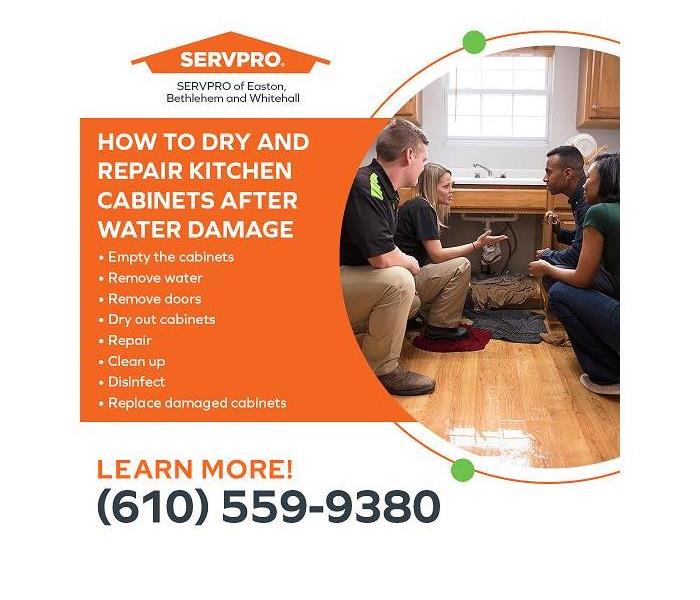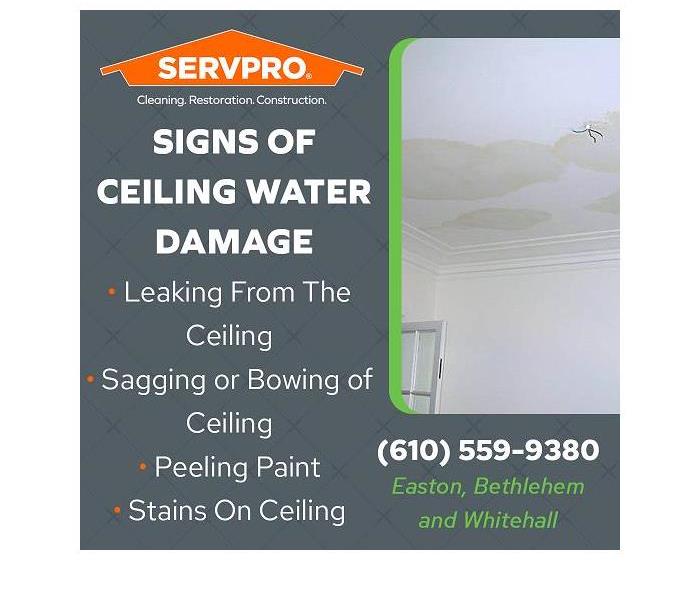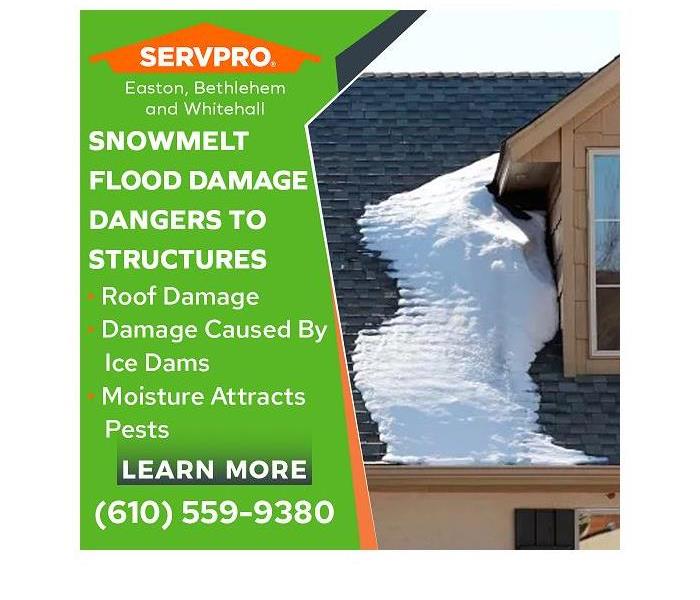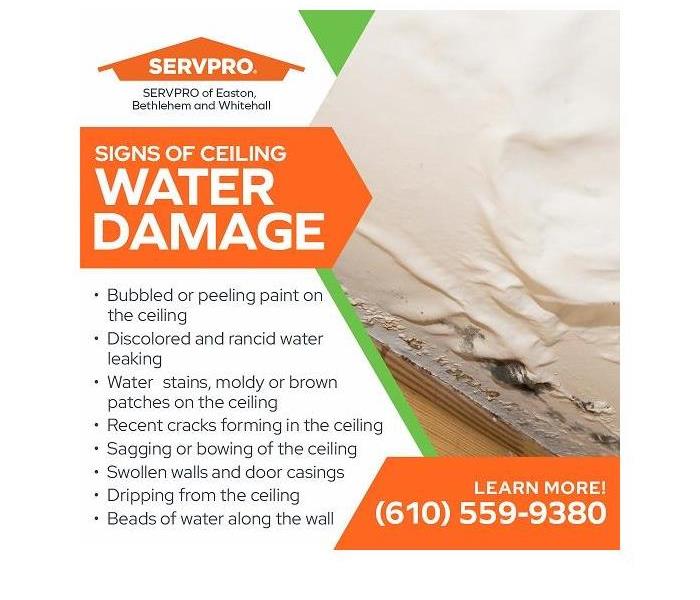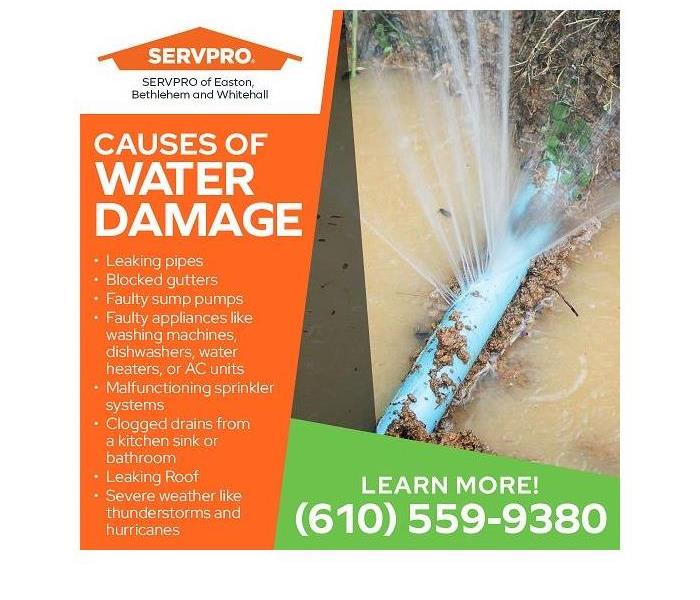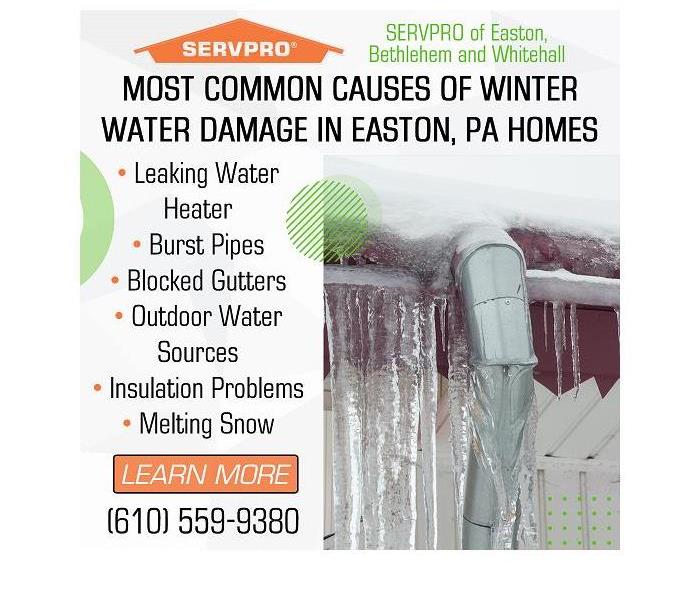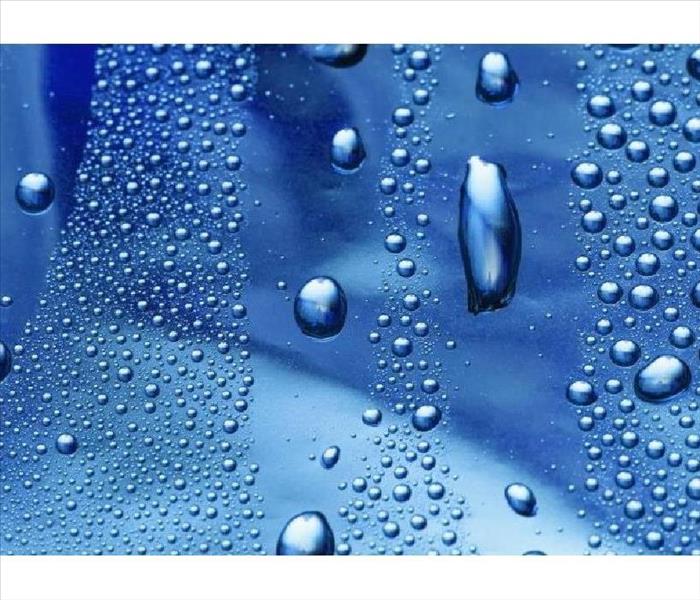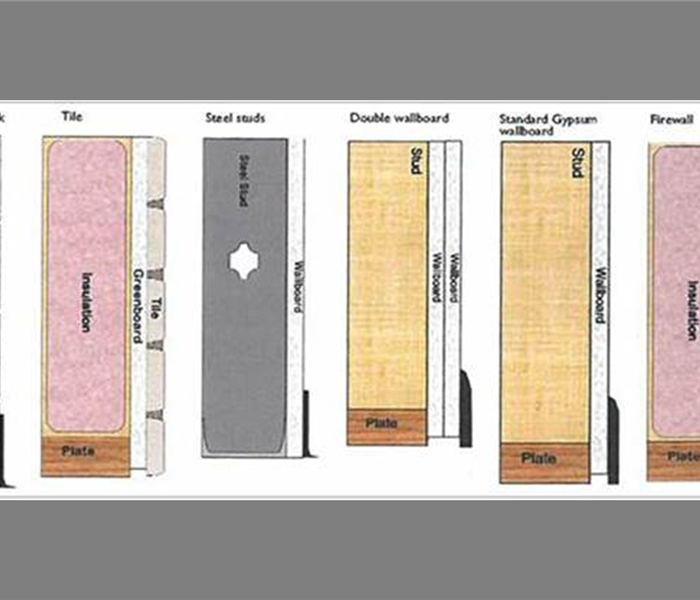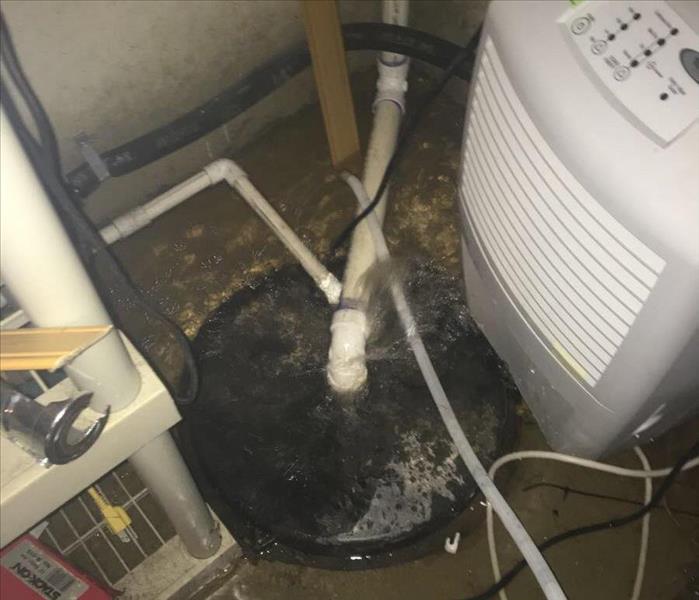Recent Water Damage Posts
Preventing Frozen Pipe Bursts
1/15/2024 (Permalink)
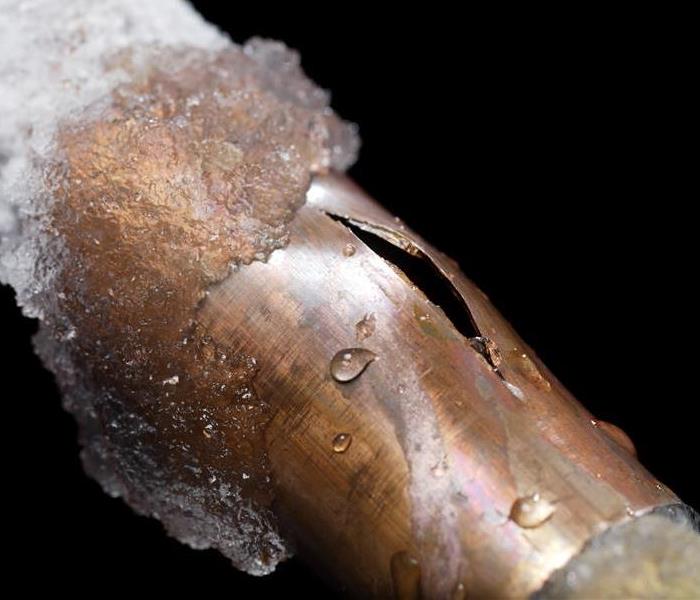 One of the most common reasons why pipes burst is due to freezing conditions.
One of the most common reasons why pipes burst is due to freezing conditions.
After a mild December, the Lehigh Valley is preparing for a very cold January as a polar vortex approaches. On top of snow and ice, freezing temperatures pose a very serious threat for commercial and residential property owners.
Pipe bursts are very frequent during these frigid times, as the water in pipes begins to freeze and expand, leading to unexpected water damage.
Luckily, SERVPRO Team Davis has the tips you need to help prevent your pipes from rupturing.
- Insulation.
- Insulating exposed pipes with foam sleeves or wraps is an effective way to keep pipes from freezing.
- Seal Air Leaks.
- Walking your property and ensuring potential air leaks from windows, doors, or ventilation fans are properly sealed is a great way to stop cold air from reaching your pipes.
- Let Faucets Drip.
- Running a small amount of water through your pipes is a common way of helping prevent pipes from freezing and bursting.
If your commercial or residential property suffers from winter storm related damage, give the highly trained restoration technicians at SERVPRO Team Davis a call!
610-559-9380
Repairing Water Damaged Kitchen Cabinets
7/12/2022 (Permalink)
Blog Summary: This article by SERVPRO of Easton, Bethlehem, and Whitehall describes how kitchen cabinets can be repaired after water damage.
The kitchen has always been an important part of a home. It is referred to as the heart of the home sometimes. Even today it is where families gather together, cook and share meals, and spend time together. Even after the pandemic kitchens have become more important as they are also used as workstations and study nooks. This is why kitchen design is very important and homeowners always try to maintain a neat and bright kitchen.
Kitchens are at risk of water damage as chances of faulty plumbing, leaky sinks, and malfunctioning appliances can expose the kitchen to water. Though the kitchen is designed and constructed to prevent water damage as far as possible, this can always happen. In case of water damage in the kitchen or anywhere else, SERVPRO of Easton, Bethlehem, and Whitehall is a water damage restoration company that communities across Pennsylvania can turn to. In this article, the water damage restoration company gives some information on the causes of water damage in the kitchen and how it can be repaired.
Causes of Water Damage In The Kitchen
- Water can spill in many instances in a kitchen, and it can be of different temperatures. Splashes of water can flow and if left for long moisture can lead to water damage.
- Kitchen appliances like refrigerators or dishwashers can malfunction and leak.
- Kitchen sink faucets can be leaky with wear and tear.
- Pipes can burst when frozen or when old. There can be small leaks that are not visible easily.
How To Dry and Repair Kitchen Cabinets After Water Damage
Once there is water damage in a kitchen cabinet the following steps can be taken.
1. Empty The Cabinets
The cabinets that have been exposed to water must be emptied. Paper goods, dish towels, and other fabrics may need to be discarded depending on the type of water damage. All food stored in boxes or bags may need to be discarded as moisture might be present in the. Glass or plastic containers that are airtight and watertight might be safe.
2. Removing Water
As much of the water in the cabinet must be removed as soon as possible. If water is left for long, the extent of water damage will be worse. After wiping the cabinets down with thick towels, they can be dried with kitchen towels till the cabinets feel dry to the touch.
3. Remove Doors
Removing cabinet doors speeds up drying and limits the water damage. Sagging and crumbling of particle board can happen due to the weight of the cabinet door. If the doors are removed they can be kept flat to prevent warping. High-volume fans can help to dry them faster.
4. Drying Out Cabinets
Once the doors are removed the kitchen cabinets can be dried. Unless the water damage is very minimal, household fans may not be efficient enough to dry the cabinets. High-volume fans and structural drying dehumidifiers get the job done. This equipment can be rented. Alternatively, a water damage restoration expert can be contacted for water damage repair. Such companies have all the specialized equipment to deal with water damage safely and efficiently. The fans may need to be repositioned periodically to cover all areas including behind and underneath the kitchen cabinets.
5. Repair
Kitchen cabinets might be repaired depending on the extent of water damage. Delaminated layers of the cabinet may be fixed with carpenter's glue and clamps.
6. Cleaning up
When cabinets are repaired after water damage, they might have water stains. Cabinets will have to be cleaned. They can be sanded down for a neat appearance. A sealant and a stain coat followed by a top coat to protect the wood will help make the kitchen cabinets look good.
7. Disinfection
After drying, cabinets may need to be disinfected. Homeowners who prefer DIY methods may use a bleach solution to remove bacteria, mold, and odors. Keeping the kitchen windows open to promote ventilation can help eliminate odor. Water damage restoration professionals will have specialized equipment and supplies to clean and disinfect the area after water damage.
8. Replacing Damaged Cabinets
Once kitchen cabinets show signs of crumbling after water damage. Especially if the cabinet is made of particle board, it is damaged after exposure to water. Beyond a certain extent of water damage, cabinets may not be usable. They will have to be discarded and replaced.
Flooding or leaking in the kitchen can turn cabinets into a soggy mess. Cabinets are made of wood, MDF, or particle wood. When particleboard gets wet, it absorbs water and can swell up. The glue that holds the cabinet dissolves when water comes in contact for a long time. The longer the kitchen cabinet is exposed to water, the faster it gets damaged. When there is prolonged exposure to moisture the risk of mold or rot is more. This is why water damage must be handled in a time-sensitive manner. Unless the water damage is minimal, the safer option is to hire a water damage restoration company to get things back to a pre-damage condition.
SERVPRO of Easton, Bethlehem, and Whitehall is a damage restoration company offering fire and water damage restoration services for residential and commercial property owners. With a focus on local communities in PA, USA, and a nationwide presence, this water damage restoration company handles water damage of any size and is available at all times in emergencies. For any water damage restoration needs they can be contacted by email at SERVPRO5770@SERVPROofeaston.com or by dialing the number (610) 559-9380.
Causes and Signs of Water Damage to Ceiling
6/8/2022 (Permalink)
Blog Summary: The causes of water damage to ceilings and the signs are described by SERVPRO of Easton, Bethlehem, and Whitehall here.
Water is at the core of our lives and human existence. Its presence is always welcome except when it causes water damage to property. Water damage can affect buildings in different parts and ways. Homeowners and business owners always strive to prevent water damage and to identify it as early as possible.
Knowing what causes water damage in different areas and how to find it is important for preventing and limiting the extent of water damage. SERVPRO of Easton, Bethlehem, and Whitehall shares information on the causes of ceiling water damage and the signs to watch out for.
When water damage affects a ceiling it must be tackled as soon as possible. Irrespective of whether the water is from an indoor or outdoor source it could accumulate leading to the collapse of the ceiling. Moisture can also cause mold growth that also weakens the structure.
Causes of Ceiling Water Damage
1. Plumbing Problems
Leaky or burst pipes, bathroom caulk that has worn away, leaking from appliances, etc can all cause water damage to ceilings.
2. Roof Leaks
Damaged roofs can cause water to enter through the attic or along the eaves of a house. Damaged shingles can let rainwater and melted snow enter homes leading to roof leaks. Clogged gutters also can cause water to accumulate and affect the ceiling.
3. Excess Moisture
Ceilings of rooms that are humid or exposed to moisture for long, like bathrooms and kitchens, can develop water damage and mold growth.
Signs of Ceiling Water Damage
1. Leaking From The Ceiling
When water is leaking from a ceiling, the plumbing above must be checked for damage. Shingles must be checked for damage when the roof is directly above the ceiling that leaks.
2. Sagging or Bowing of Ceiling
When water fills the ceiling material it weakens it. The weight of the water leads to bowing or sagging of the ceiling. This can occur in ceilings of drop tile, drywall, or plaster.
3. Peeling Paint
When the ceiling is exposed to water for a long time, it can lead to peeling or bubbling of the paint. Plaster ceilings can develop cracks, as when exposed to water plaster expands and shrinks causing cracks.
4. Stains On Ceiling
Especially on white ceilings water damage can show discoloration. Yellowish-brown spots indicate that the leak has had time to dry, and so it may be small. Ring-like patterns are seen when leaking happens repeatedly and water spreads away from the source over time. Discolored spots on the ceiling indicate a ceiling leak, even if the ceiling appears dry to touch.
Repairing Ceiling Water Damage
The leak must be found and this must be repaired. The wet ceiling must then be dried out as soon as possible. This limits the extent of water damage and reduces the risk of mold growth. A professional water damage restoration company will use high-volume fans and a structural drying dehumidifier to dry the ceiling quickly and thoroughly. The water-damaged ceiling can be repaired. If the water damage is minimal, replacement of drywall and plaster may not be necessary. Cleaning and sanitization can be done. But sometimes cracks may need to be repaired or the ceiling replaced in affected areas. The area can then be painted, including a layer or two of sealing primer.
Ceilings provide protection and also add to the aesthetics of a home. They keep beams, pipes, and wiring out of plain sight. Water damage must be handled promptly to prevent the problem from spreading to other parts of the building and worsening. SERVPRO of Easton, Bethlehem, and Whitehall is equipped to handle water damage in Schnecksville, PA. They are available 24/7. For the best water damage restoration services at the best prices, SERVPRO of Easton, Bethlehem, and Whitehall can be contacted by calling (610) 559-9380.
SERVPRO of Easton Provides Simple Steps to Avoid Flood or Restore Flood Damages
4/16/2022 (Permalink)
Blog Summary: SERVPRO explains Snowmelt Flood Damage, How to Avoid it, and Why Swift Restoration is Essential to Health and Safety.
Snowmelt Flood Damage Cleaning and Restoration Services at SERVPRO
As warmer weather approaches, one of the first things home and business owners should worry about is minimizing flood damage caused by snowmelt. The areas of Easton, Bethlehem, and Whitehall average more than 45 inches of rainfall and 30 inches of snowfall per year. Not being ready for that volume of water can lead to significant flood damage. When you have water damage, SERVPRO of Easton, Bethlehem and Whitehall responds quickly to help minimize damage and begin the restoration process.
How to Minimize Snowmelt and Flood Damage
A commonly overlooked result of heavy snowfall and ice accumulation during the winter is the potential water damage that can occur when the snow melts. Runoff from rain and melted snow, or things like frozen pipes and ice dams, can quickly overwhelm drainage systems and end up damaging your property. You can minimize flood damage by taking a few proactive steps.
Move the Snow
Move piled snow as far away from the property’s foundation as possible and to an area where it will not cause damage.
Clean the Gutter System and Downspouts
Remove debris that can clog the system. Cleaning gutters will help direct water to the proper places and away from the building structure. It is advisable to use snow melt tabs to break down snow and ice stuck in the gutters. To prevent large amounts of water from snowmelt runoff or spring rainstorms pooling close to your property, attach a sloped leader to your downspouts. These extensions carry the water farther away from the structure, minimizing the risk of water or flood damage.
Remove Excess Snow
It is possible to prevent the need for water damage restoration and encourage water flow by hiring a contractor to remove excess snow from the roof.
Seal Cracks in Your Foundation, Doors, and Windows
Water is a powerful and destructive force against your property. Because of this, it is important to secure entrances and exits, windows, and cracks in the foundation against water intrusion. Once water enters, it begins to degrade the materials and can cause other problems that pose potential health effects, such as mold.
Install a Sump Pump
If you do not have a working sump pump, have one installed, or take time to inspect your existing pump. Ideally, this device should prevent flooding and flood damage to your basement or foundation, but it must be running optimally. If the pump has a battery back-up, install new batteries for the season, and make sure the pump and drain are in good working order. Pour water into the pit to test its functionality.
Pay Attention to Weather Forecasts
A rainstorm or a rapid increase in temperature that causes snowmelt can overwhelm a structure’s ability to shed water away from the roof and foundation and lead to serious water damage.
Snowmelt Flood Damage Dangers to Structures
Snowmelt flooding occurs yearly in localized areas and can devastate a business or homeowner. Here are just a few of the damages caused by cold weather water and its effects.
Roof Damage
The accumulation of snow on the roof adds weight that can cause small cracks to the roofing system. With temperature fluctuations, the water can get into those cracks and then expand the cracks with the next freeze. When temperatures rise and the snow melts rapidly, water can seep into the cracks and make its way further into the roof structure causing roof rot, and other problems.
Damage Caused By Ice Dams
Ice dams, or the dam at the edge of the roof near the eaves, prevent snow melt from draining off the roof properly and can cause standing water. The standing water can cause problems such as roof rot, leaks, damaged shingles, as well as damage to gutter systems, ceilings, walls, studs, and insulation.
Moisture Attracts Pests
One of the lesser considered problems with flood damage is attracting pests. Pests such as mice love to find weak areas in the foundation or structure to make their way into a building. Once inside, they can cause untold damage to insulation, wiring, and more.
Flood Damage Restoration Near Me? Call SERVPRO.
Cold weather and winter storms can cause significant damage with no warning. Regardless of the type of storm, the highly-trained team at SERVPRO of Easton can handle any size flood damage event and provide rapid response. For residential or commercial flood restoration services in Bethlehem, PA, and surrounding areas, call (610) 559-9380 or email SERVPRO5770@SERVPROofeaston.com today.
The Causes, Signs, and Management of Ceiling Water Damage
3/1/2022 (Permalink)
Blog Summary: This article by SERVPRO of Easton, Bethlehem, and Whitehall explains what causes water damage to ceilings, its signs, and what can be done after it happens.
Water damage can be very dangerous to homes, commercial property, and belongings. Statistics say 1 in 50 insured homes has a water damage (including damage related to freezing) claim each year. Water damage can be very costly. It involves water removal, cleanup, drying, disinfection, and repair and restoration costs. It also depends on many factors like the extent of water damage, the type of water causing the damage, and the cost of labor and materials in the area.
Water damage can be caused by weather conditions like thunderstorms, clogged gutters, leaky pipes or appliances, blocked drains, etc. Water damage can affect buildings in so many ways. There can be damage to almost anything including the foundation, walls, floors, furniture, furnishing, electronics, etc. Property damage restoration companies help to restore the property to pre-damage conditions. In this article SERVPRO of Easton, Bethlehem, and Whitehall gives some information on ceiling water damage.
Ceiling water damage results from excess water seeping into the ceiling. This usually happens from a leak above. This kind of water damage can lead to mold growth and structural weakening. It can even lead to a collapsed ceiling and extensive property damage.
Signs of Ceiling Water Damage
- Bubbled or peeling paint on the ceiling
- Discolored and rancid water leaking
- Water stains, moldy or brown patches on the ceiling
- Recent cracks forming in the ceiling
- Sagging or bowing of the ceiling
- Swollen walls and door casings
- Dripping from the ceiling
- Beads of water along the wall
Causes of Ceiling Water Damage
- Plumbing leaks can lead to water from rooms above to drip into the ceilings of the rooms below causing water damage.
- Roof leaks and damage after storms can lead to water damage to the ceiling. Signs of water damage from leaking roofs include damp drywall, wet wood beams, and water or excess moisture in the attic. Roof leaks can cause discolored spots in the ceiling called water spots.
Results of Ceiling Water Damage
- Unpleasant appearance
Peeling paint and plaster, discoloration of the ceiling, damaged wallpaper and trims, and a sagging ceiling are all caused by ceiling water damage. This creates an unappealing look.
- Mold
Mold can grow after water damage to the ceiling and this can spread all over the house.
- Fire Risk
Electrical wiring can be exposed to water content in the ceiling. This is a fire hazard.
- Risk of Falls and Injury
Water-damaged ceilings can leak, forming puddles on the floor. This is a fall risk, especially if there are little children or older adults.
- Increased Utility Bills
Ceiling water damage can affect the insulation and this affects its performance, contributing to a rise in electricity bills.
What To Do After Ceiling Water Damage is Noticed
Water damage to the ceiling can spread to other parts of the house. Steps must be taken to prevent this. Furniture or other objects must be removed if water can drip on them from above. Containers can be placed to collect the water to prevent the floor from getting wet. Drywall can absorb and spread the water. So localizing the leak by using a tarp or making a hole for water to come out helps to stop the spread and limit the water damage.
An inspection must be done to identify if there is an internal ceiling leak or an external ceiling leak. This must be done with caution to avoid any danger like exposure to asbestos, lead-based paint, or mold, and risk of falls from ladders or due to weak structures. If the source of water can be controlled or repaired, that must be done first.
Homeowners might be able to handle minimal ceiling damage by themselves. The leak or source of water must be identified and stopped, the wet ceiling must be dried, damages to the ceiling must be repaired, and when complete it must be sealed and painted. But for any more damage or for homeowners who find this difficult it is best to get assistance from a water damage restoration company.
A company like SERVPRO of Easton, Bethlehem, and Whitehall has highly trained technicians, and the most advanced specialized equipment to handle any water damage. They offer residential and commercial restoration and cleaning services required after a disaster of any size that leads to fire or water damage. This company offers 24/7 emergency services and helps manage insurance paperwork and processes in Northampton, PA, and surrounding areas. Customers looking for restoration services by trained and certified professionals with a compassionate approach can contact SERVPRO of Easton, Bethlehem, and Whitehall on (610) 559-9380 or via email at SERVPRO5770@SERVPROofeaston.com
What is Water Damage and its Classes and Categories?
2/4/2022 (Permalink)
Blog Summary: What water damage is, its causes, and types are outlined by SERVPRO of Easton, Bethlehem and Whitehall.
Water damage is a common cause of property damage in the United States. Industry estimates place the number of people experiencing a water damage emergency at homes or workplaces at 14,000 a day. Insurance companies pay billions of dollars every year on claims related to water damage and subsequent mold. Household water leaks cause a trillion gallons of water loss a year.
The figures above reveal why water damage is something to be aware of and prevented, as far as possible. SERVPRO of Easton, Bethlehem and Whitehall explains what water damage is.
According to Wikipedia, water damage describes the possible losses caused by water intruding where it will enable the attack of a material or system by destructive processes like the rotting of wood, mold growth, bacterial growth, rusting of steel, swelling of composite woods, delamination of materials like plywood, etc. In general, any destruction of property interiors or external structures of a building from a water related source is water damage.
Water damage can affect buildings in many ways. There can be floor warping, discoloration of walls, mold formation, vermin infestation, and even weakening of foundations. Water damage is sudden and can cost a lot to repair and restore. Hence, quick and professional water damage restoration services are important to limit the damage and expenses.
Causes of Water Damage
Leaking pipes
Blocked gutters
Faulty sump pumps
Faulty appliances like washing machines, dishwashers, water heaters, or AC units
Malfunctioning sprinkler systems
Clogged drains from a kitchen sink or bathroom
Leaking Roof
Severe weather like thunderstorms and hurricanes
It must be noted that from the perspective of insurance, flood damage is considered different from water damage. Damage resulting from floods is covered by separate insurance that homeowners in flood-prone areas can choose to purchase. Water damage also has to be sudden and accidental. Insurance claims typically will not cover water damage caused by negligence and poor maintenance of homes.
Classification of Water Damage
The class of damage a water damage incident falls into is determined by the degree of damage to the property. There are four classes of water damage.
Class 1
Class 1 water damage is caused by uncontaminated water and minimal water absorption, affecting either a portion of a room (less than 5% of the total square footage including floors, walls and ceilings) or an area where materials have low porosity and the room has a slow evaporation rate.
Class 2
An entire room is affected but only 5-40% of the entire square footage of the room (floors, walls and ceilings). There is the presence of porous materials such as carpet and carpet padding which absorb water needing extraction. Water may have wicked up the wall less than 2 feet, and there is moisture in structural materials. This class of damage has a fast evaporation rate and the time required to dry the area will increase.
Class 3
More than 40% of the total square footage of the impacted area is affected. There is significant water absorption in the flooring, insulation, subflooring, structural materials, and water has wicked up the walls at least 2 feet. Class 3 water damage has the fastest evaporation rate. Water removal will take longer and may require special equipment to dry sufficiently. This class of water damage usually results from an overhead source such as a burst pipe in the ceiling or water intrusion from the roof.
Class 4
Class 4 water damage means a significant amount of water has had time to be absorbed into low porosity materials like plaster, hardwood flooring, and concrete. Water removal in this class of damage is complex and water damage restoration will require specialized equipment and takes more time to remediate than the other classes.
Categories of Water Damage
Based on the level of contamination of water causing damage within a building, there are 3 categories of water damage.
Category 1 Water - here the source of water is sanitary or considered to be minimally contaminated, hence referred to as clean water. This includes tub or sink overflows, and broken water supply lines.
Category 2 Water – water causing damage contains contaminants that can lead to discomfort or health effects if consumed. This is called gray water. Water is usually from appliances like dishwashers or washing machines, water beds, aquariums, or toilet bowls with urine (no feces).
Category 3 Water – is grossly contaminated water called black water. Black water is highly unsafe and should not be consumed or handled without proper safety measures in place. This water includes sewage, seawater, water rising from rivers or streams, storm surge, toilet backflows, etc.
Water damage restoration is best started as quickly as possible. Water damage affects property, possessions, and treasured keepsakes. Apart from the damage to furniture, appliances, electronics, and documents, even the structure of buildings can be damaged.
Water damage affects homeowners physically, financially, and emotionally. SERVPRO of Easton, Bethlehem and Whitehall understands the stress that comes with water damage and the associated disruption caused to the life of a homeowner or business owner. Their highly trained staff offers professional water damage restoration services. They can be contacted on (610) 559-9380 or via email at SERVPRO5770@SERVPROofeaston.com
5 Ways To Protect Your Home From Water Damage While on Vacation
12/15/2021 (Permalink)
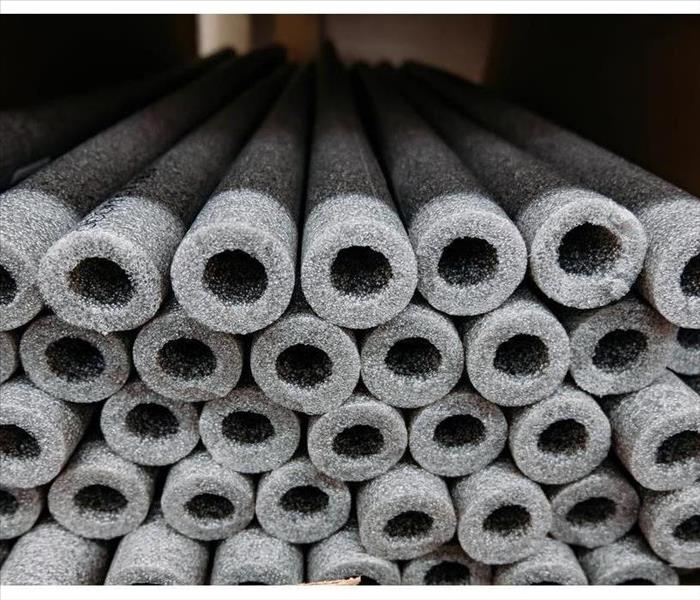 Insulate exposed pipes.
Insulate exposed pipes.
5 Ways to Prevent Water Damage in Your Home While on Vacation
Whether it’s a weekend getaway or an extended trip, you, like many homeowners in Palmer Township, PA, may look forward to a relaxing vacation. Upon your return, the last thing you probably want or expect to find is a flooded house requiring water pipe repair. Unfortunately, every home is potentially susceptible to broken pipes and water damage, especially during the winter. You can, however, take several proactive measures to help safeguard your residence and personal property while you’re away.
1. Insulate Exposed Pipes
Attics, basements and garages are often uninsulated. Exposed pipes in these areas may freeze and burst during the winter. To minimize this risk, you should insulate accessible pipes in the cooler regions of your home.
2. Turn Off the Water Main
Restricting water flow can also help prevent a broken pipe. Before you leave for vacation, consider turning off the water main.
3. Drain Pipes
You can help further reduce the need for water pipe repair by draining your home’s pipes. After you shut off the water supply, open every faucet, including the outdoor ones, to eliminate any fluid remaining inside the plumbing system.
4. Keep the Heat On
You may consider it a waste of energy to keep your home’s heater on if the residence is unoccupied. However, turning the unit off during the winter leaves your pipes vulnerable to freezing. Instead of disabling your heater, consider adjusting the thermostat. You should, however, refrain from lowering the setting below 55°F.
5. Open Cabinet Doors
To help prevent a broken pipe under your kitchen and bathroom sinks, you can open the cabinet doors. This helps warm air circulate more efficiently.
Flood cleanup and water pipe repair are often daunting and tedious tasks that many homeowners hope to avoid. Taking precautionary measures to prevent burst pipes can provide peace of mind that your home will be safely intact when you return from vacation.
What Leads to Winter Water Damage in Easton, PA Homes?
12/15/2021 (Permalink)
Blog Summary: Winter water damage in Easton, PA is commonplace in most homes. This article explores the common causes of winter water damage. Read on to learn and prepare yourself for the next winter.
Cold winter temperatures in Easton, PA come with their fair share of challenges, including winter water damage, which can destroy your walls, carpet, furniture, and electrical appliances. Here are the most common causes of winter water damage in Easton, PA homes.
Leaking Water Heater
As temperature drops, water heaters are forced to work harder to heat up. In turn, the water heater has to run long hours to keep the water hot. If you have an old heater, this constant running might cause it to leak or burst, leading to flooding.
Burst Pipes
When the temperatures drop below freezing point, water inside poorly insulated pipes also freezes. When the water inside the pipe freezes, it can expand by 9% of its original size, which causes the pipes to burst. Burst pipes can result in extreme water damage to your walls and floors.
Blocked Gutters
Gutters often direct water away from your home to avoid damaging your property. However, water will leak under the shingles and into your home when your gutters are blocked with debris or ice. This will cause water damage to your home.
If ice or snow is melting from your roof and flowing into the blocked gutters, your home probably has faulty insulation that allows heat to escape and melt the ice or snow. Therefore, it would be best to fix your insulation and clear your gutters to ensure water flows into a safe place and prevent the formation of ice dams. You also need to inspect your shingles for damages and fix them to stop water from seeping into your house.
Outdoor Water Sources
The freezing temperature makes outdoor water sources a safety risk. Therefore, it is prudent for you to have safety measures in place to avoid any water damage issues. This means that you need to drain all garden hoses and keep them in a warm place. In addition, it is wise for you to shut off all outdoor water valves. If a water pipe bursts during winter, it may cause water to flow into your home, leading to flooding. Therefore, you have to enlist the services of a water damage restoration or flood restoration service to correct this fault as quickly as possible to prevent mold formation and growth.
Insulation Problems
All exposed pipes have to be properly insulated to prevent freezing. If not, the cold winter temperature might cause the freezing of continents within the pipe, leading to the rupture of pipes. Insulate your exposed pipes using fiberglass or foam pipe insulation.
Melting Snow
Snow on your roof could melt because of several reasons and permeate your house's foundation. If you do not attend to this and correct it, the water will cause cracks in your foundation. In addition, melting snow on your roof can destroy your home's roof and leak in through the ceiling. This can cause water damage to your ceiling and the wooden structure on your roof. It can also cause mold formation. To correct these issues, contact a water damage restoration service provider to assess the extent of the damage and restore your house to its original state.
SERVPRO of Easton, Bethlehem and Whitehall is a reliable water removal service provided with a wealth of experience. You can call the company at (610) 559-9380 or email them at SERVPRO5770@SERVPROofeaston.com to book an appointment or request emergency services. You can visit their offices located at 860 N Kiowa St. Allentown, PA 18109.
Does Homeowners Insurance Cover a Flooded Basement?
11/18/2021 (Permalink)
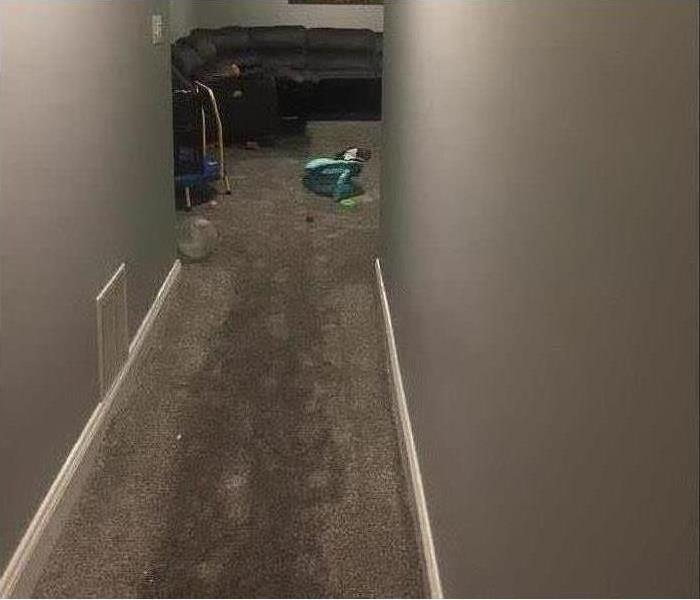 A flooded basement in Forks Township, PA.
A flooded basement in Forks Township, PA.
Homeowners' insurance policies cover most accidental damage, even if the cause is not a covered peril. You may increase the chances that your insurance company will cover damage by taking preventative measures and performing regular maintenance. Here are three considerations to help you determine whether you can count on insurance coverage in the event of a basement flood.
What Caused the Basement to Flood?
There are several reasons a basement can flood. Water may originate from
- A broken pipe
- A leaky water heater
- Heavy rains
- Flooding
- Sewer backup
- Washing machine overflow
Unless you have proof of recent inspections and regular maintenance, most of these causes are not covered perils. The water damage that results is likely to be covered, unless the cause is flooding, which is only covered by a separate flood insurance policy.
Which Maintenance or Preventative Measures Have You Taken?
In addition to inspections and repairs, you may need to prove you have done everything you can to prevent a basement flood and mitigate the damage in a timely manner. Make sure your sump pump is operational and has a backup power source. Heat your home in freezing weather and allow a faucet to drip to prevent pipes from bursting. Flush and inspect your water heater several times a year. Regardless of the cause, contact your insurance company as soon as water floods your basement.
Have You Done All You Can To Mitigate the Problem?
As long as you take extensive photographic and video evidence of a flooded basement, you can start to mitigate damage before an adjuster arrives. Turn off the water supply if it will slow or stop the flow of water.
Contact your insurance company to schedule a basement flood appointment with a claims adjuster. You can also obtain estimates from a plumber or appliance repair specialist and a home restoration service in Forks Township, PA.
Old Property, New Tricks: Plumbing Maintenance
9/20/2021 (Permalink)
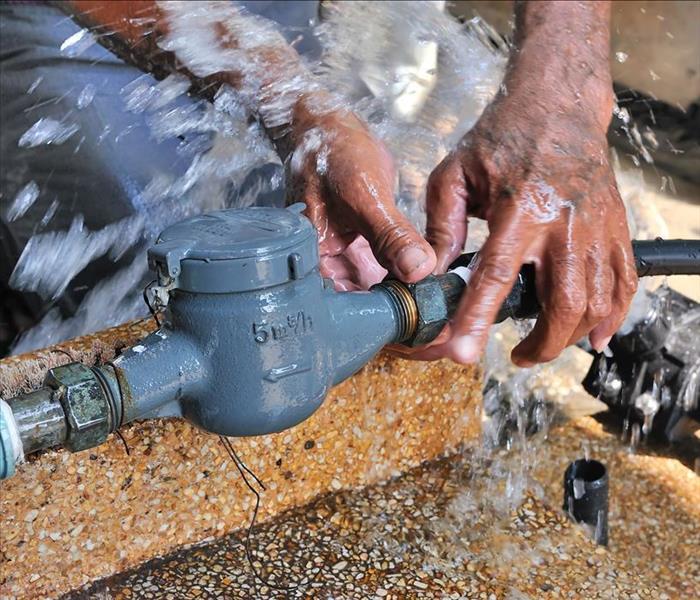 Most of the quirks are manageable, however, if you stay on top of your maintenance routine.
Most of the quirks are manageable, however, if you stay on top of your maintenance routine.
Consistent, timely maintenance is important in any rental property to keep tenants happy and keep your building structurally sound. Older buildings tend to have more plumbing problems than new buildings, particularly if they were outfitted with polybutylene pipes. Therefore, you must be even more vigilant if you own a building in Easton, PA, that was not just constructed. Here are some helpful maintenance tips.
Unit Maintenance
Most clogs are caused by an individual blockage in a particular unit. Maintenance is generally not difficult on these clogs. You should keep a few things on hand to help you fix the problem:
• Drain auger (also known as a snake)
• Plunger
• Enzyme treatment
Most clogs can be loosened with an auger or plunger. The auger grabs the material clogging the drain and pulls it out while the plunger uses air pressure to force the clog through the pipe. If you notice recurring problems in the same unit, a monthly enzyme treatment may be helpful. If the clog causes the unit to flood, you may also need professional remediation services.
Property Maintenance
Old pipes made of polybutylene tend to flake and deteriorate the more they are exposed to the chemicals used to make water clean. This is partially why builders stopped using them in the late 1990s. If your rental property has these kinds of pipes, you may need to replace them at some point so that you don't keep having leaks that could cause severe water damage to your building. Other problems to look for are the roots of established trees. They tend to break pipes as they grow. A root killer flushed down a toilet twice a year can kill the roots that are encroaching upon your pipes without harming the tree itself.
Whether you are dealing with issues resulting from faulty polybutylene pipes or the third instance of a clogged sink from the same unit, it's important to acknowledge that older properties come with their quirks. Most of the quirks are manageable, however, if you stay on top of your maintenance routine.
4 Things To Do When Your Basement Floods
6/22/2021 (Permalink)
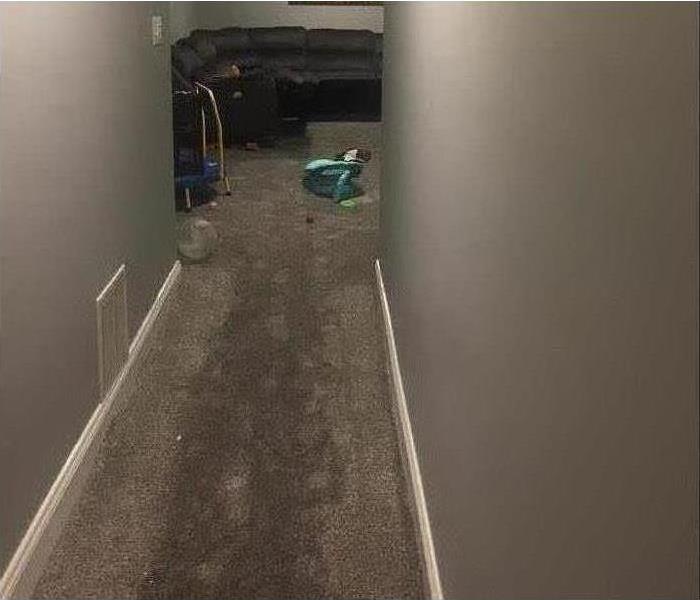 Flooded basement in Palmer Township, PA.
Flooded basement in Palmer Township, PA.
How Should You Deal With Standing Water In Your Basement?
The last thing you want to find in your Palmer Township, PA, home is a flooded basement. However, after a big storm, pipe burst or sewage backup, you may have to deal with this catastrophe.
1. Call in the Professionals: As a homeowner, you may try to take care of some projects on your own. Dealing with standing water in any part of your home requires expertise. A professional residential flood remediation team can help you figure out the best repair plan that falls under your insurance coverage.
2. Remove Standing Water: The professionals will work hard to remove standing water from your home. A basement flood should be drained before anyone enters the lower levels of your home. Make sure the electricity to the basement is turned off before anyone goes into the water for added safety. In fact, it's best if the water is removed with a shop vac and other equipment that does not require someone to stand in the waters.
3. Salvage Content: Some of your belongings may be salvageable. Any nonporous materials can be cleaned and dried out. Other items, such as electronics and appliances, may need to be thrown away rather than saved. Let the experts help you clean your belongings so you can make sure everything is done right.
4. Prevent More Flooding: You do not want to have to deal with a basement flood regularly. To save yourself some hassle in the future, you should think about installing a sump pump. This equipment can help keep water from building up.
A basement flood can surprise you. You go to bed one night and wake up the next morning to find standing water in the lower levels of your house. Acting quickly can help you avoid mold growth and other secondary damage caused by standing water.
The Value of Regular Water Heater Maintenance
3/3/2021 (Permalink)
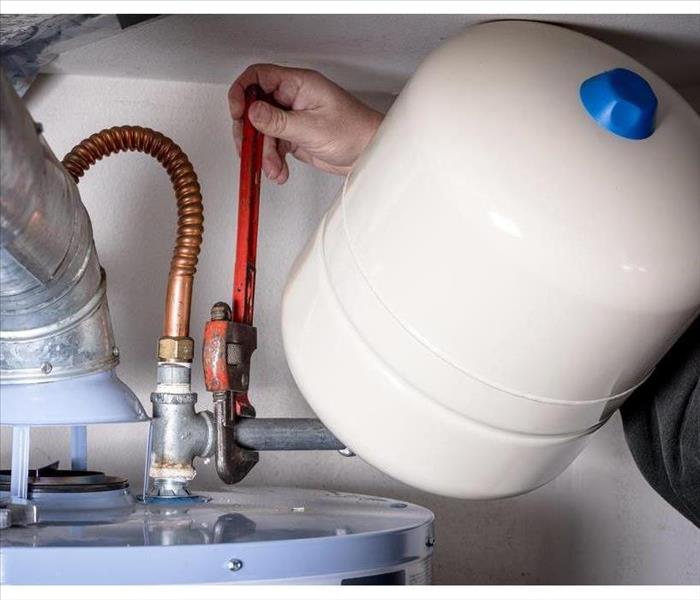 Your water heater should be maintained regularly.
Your water heater should be maintained regularly.
Nowadays, a modern home is filled with miraculous devices that many people take for granted. At the press of a button, the flick of a switch or the turning of a handle, people have access to running water, controlled cooking flames and light. The water heater is one such amazing device. It essentially brings hot water to your fingertips whenever you want it. Your unit requires little in the way of maintenance and it will last a good ten years in most cases. With a little maintenance and extra care, though, you might be able to extend the lifespan of your unit and maybe even avoid a damaging water spill.
Indications Your Water Heater Is Misbehaving
As with any other appliance or mechanical device, your hot water tank will show signs of trouble if something is amiss. This often comes in the form of unusual sounds. If you hear any of the following, it could be a good indication your device is in a bit of trouble:
- Cracking, popping and rumbling
- Humming
- Knocking or hammering
- Screaming and screeching
- Tapping
Upon hearing any of these sounds, it is time to take action. Either call a licensed plumber or attempt to troubleshoot the situation yourself. In many cases, the problem is minor and the adjustment of a valve or the replacement of a piece of hardware is the solution. At times, a water heater flush is needed to remove sediments that have collected on the bottom of the tank.
Implications of Neglect
If you are not careful and vigilant, your water heater can fail all at once, emptying forty or fifty gallons of water into your home in Easton, PA. This can cause damage to flooring and other elements of the house. To mitigate the situation, the services of a water damage franchise are often needed to clean up the area and minimize damages. Any appliances that use water should be maintained regularly to avoid a water spill in your home.
What To Do If a Pipe Bursts in Your Commercial Building
2/10/2021 (Permalink)
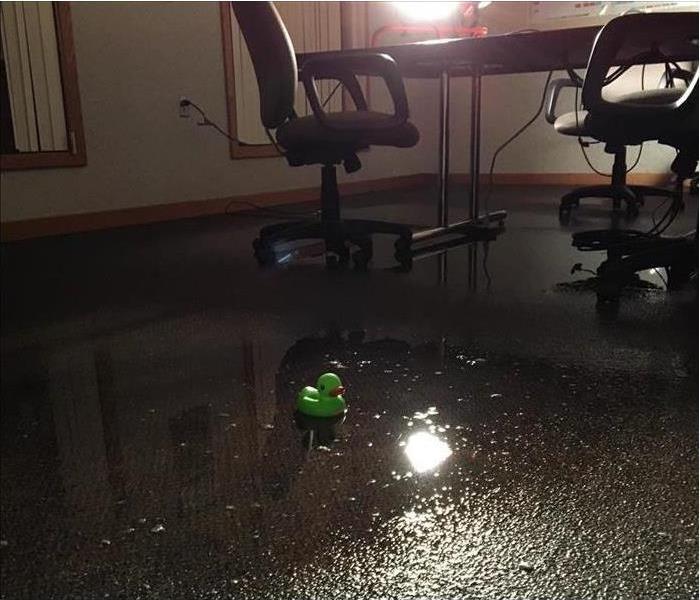 Water damage in Stockertown, PA.
Water damage in Stockertown, PA.
If You Encounter Bursting Pipes Here Are Some Steps You Should Take
Older commercial properties are particularly broken to frozen pipes. However, this phenomenon can occur in newer buildings as well. Water flowing through any cold, uninsulated pipes may freeze into ice. As the ice expands, it can put pressure on the pipes until they break. This could lead to massive water damage in Stockertown, PA.
1. Shut Off the Water and Electricity
The water will continue to escape from the burst pipe until you shut off the main valve. Make sure that everyone in the building knows where this valve is. You should also turn off the electricity in the damaged part of the property. This will prevent electrocutions during the drying process.
2. Call a Professional
A broken pipe can leave you with a huge puddle of water in your building. The water may also soak your walls, carpets, or ceilings. Over time, this could lead to the growth of mold that causes even further damage. You thus need to contact emergency cleanup professionals as soon as you discover the bursting pipes. Look for a company that provides 24-hour service. Even a few-hour delay could have severe consequences.
3. Take Preventative Measures
Once the cleanup is complete, talk to the experts about limiting additional pipe breaks. They can tell you how to spot and thaw frozen pipes before they burst. You can use warm washcloths or hair dryers to heat up the pipes. You may also want to keep a trickle of water flowing through the pipes at all times. This will stop the water from freezing.
Frozen pipes can flood your Stockertown, PA, property during the winter. If this happens to you, turn off the water immediately and contact experts who know how to fix a broken pipe. The professionals can also help you prevent bursting pipes in the future.
Replace Your Leaking Toilet in 3 Simple Steps
1/12/2021 (Permalink)
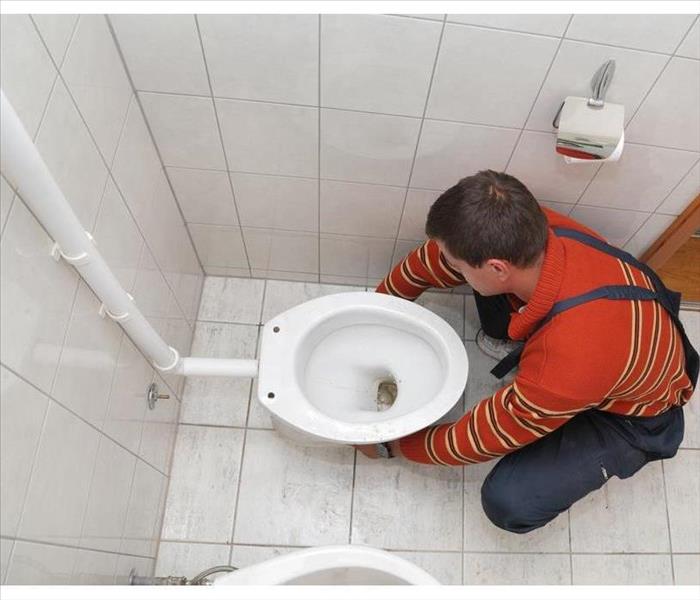 Installing a new leak-free toilet
Installing a new leak-free toilet
Follow The Steps Below and Avoid Mishaps
A leaking toilet can result in structural damage to your home; sometimes, they even require a water damage restoration specialist. But that doesn't have to happen. Tackling the problem early can help you avoid damage and more extensive repairs later on. Luckily, it only requires a few tools and some basic DIY skills to replace an old toilet.
Step 1: Gather Your Supplies
Toilet repair is something that pretty much every homeowner will have to handle at some point, so you will want to have the right tools for the job. Here's what you'll want to have on hand to replace a leaking toilet:
- Adjustable wrench
- Both Phillips and slotted screwdrivers
- Small hacksaw
- Putty knife
- Bucket
- Large rag or piece of cardboard
Step 2: Remove the Existing Toilet
Once you have the right tools together, you can begin to address the offending toilet. Using the shut off valve, turn off the water. Flush the toilet to drain most of the tank and scoop whatever remains into a bucket or nearby drain.
Carefully uncover the bolts attaching the bowl to the floor. Using the adjustable wrench, loosen and remove the nuts. Lift the bowl straight up and off the bolts, then scrape the excess wax from the bottom. Place it off to the side on a large piece of cardboard or a heavy towel. Remove any wax remaining around the toilet flange.
Step 3: Install the New One
Now comes the fun part: Installing your new leak-free toilet. Install an appropriate replacement wax ring onto the flange. Note that the closet bolts are installed into the gasket. Place the bowl of your toilet over the bolts and press gently to seat it. Tighten the nuts evenly until it is firmly secured and trim off the excess bolt length with the hacksaw. Now you can install a new water supply line to the shutoff valve and toilet supply, then flush the toilet a few times to check for leaks.
Replacing a leaking toilet is a straightforward process that many homeowners in Palmer Township, PA, can accomplish. Be sure to use patience and follow the steps carefully to avoid any mishaps.
How To Handle Water in Your Light Fixtures
11/19/2020 (Permalink)
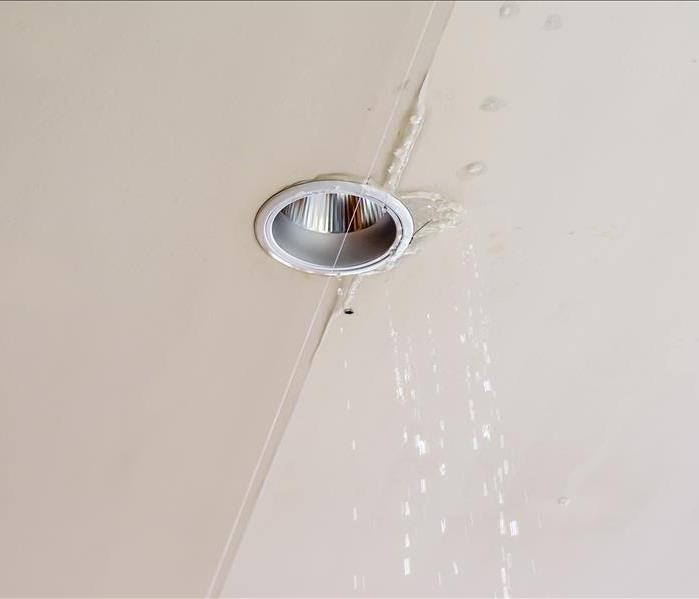 If you ever suspect water in light fixtures, call professionals immediately to fix the problem
If you ever suspect water in light fixtures, call professionals immediately to fix the problem
After enduring a heavy rain storm in Easton, PA, it's important to inspect your home for damage. Many water leaks remain hidden in the ceiling or inside the walls. These hidden leaks usually don't become visible until severe damage has already taken place. Water in light fixtures isn't something you would normally look for after a storm. If left unattended, however, it can cause serious damage to your home.
How To Handle Water in Your Light Fixtures
If you spot water in any of your home's lighting fixtures, you must act immediately.
Shut off the electricity - Turn off the electricity at the breaker box. Verify that the electricity is off by testing a dry electrical source. A voltage tester that is designed for non-contact use is ideal.
Turn off the water supply - If you know that the water is coming from a pipe that is broken or leaking, shut off the water at the main shutoff valve.
Contact a plumber - Call a professional right away to determine the cause of the leak and to repair the problem.
Call an electrician - It is critical to contact an electrician when you spot water in light fixtures. The expert is trained to remove the damaged fixture and replace it with a new model.
If water has caused damage in your home, you must contact a water damage repair service to assess the damage. The professional provides the tools and equipment necessary to repair and restore your property and belongings.
What Causes Water To Pool in Light Fixtures?
A faulty roof is the main cause for concern. When water leaks through the damaged roofing materials during a storm, it eventually makes its way through the ceiling and into light fixtures and ceiling materials. Visible ceiling damage leaves a stain or discoloration on the ceiling materials.
If you ever suspect water in light fixtures, call professionals immediately to fix the problem and restore your home.
Why and How To Flush Your Water Heater
10/6/2020 (Permalink)
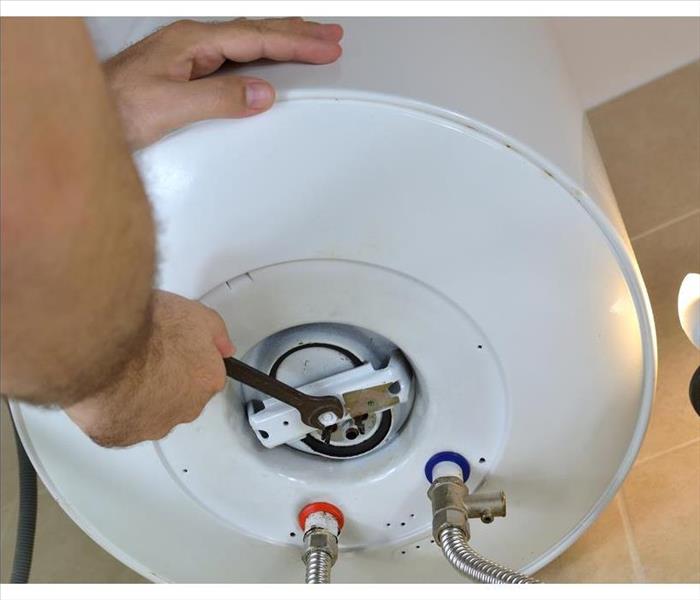 Flushing a water heater in Churchville, PA
Flushing a water heater in Churchville, PA
Maintaining your water heater is an essential part of responsible homeownership. Diminish the odds of suffering a costly repair bill or, even worse, needing to replace your system entirely by taking time out to care for yours.
Why Flush
Besides preventing an untimely demise, conducting periodic flushes:
- Reduces noise
- Improves speed
- Lowers energy costs
- Cleans out sediment
- Prevents foul odors associated with stagnant water
Performing a water heater flush need not be complicated or take long. Periodically executing this chore assures your appliance can continue reliably providing your household with clean, hot water well into the future.
How To Flush
First, switch off your machine. If your heater runs on gas, double-check that the pilot has been extinguished before continuing. For an electric water heater, access the circuit breaker to execute a complete shutdown.
Next, screw your garden hose onto the drain valve and place the loose end where you do not mind the evacuating water and sediment being deposited. Remember that wearing protective gloves during this stage is a wise decision.
Draining can now take place. Open the valve and let everything flow. Once a few minutes have passed, speed up the drainage by turning on the hot water in your kitchen. Wait some more and then switch the supply valve back to on until the flow completely halts. A quick, secondary flush is typically recommended.
With the old water completely expelled, you can once again activate your water supply. When your kitchen’s faucet is running smoothly and consistently, you will know the job has been completed properly. After confirming that the tank has refilled, restore power to the unit. The only task left is to turn on the heat source.
Needing a water restoration cleanup service to rush to your residence in Churchville, PA, and repair the fallout of a destroyed water heater can be entirely avoidable. Thankfully, with just a few, quick steps you can lower the possibility of such a calamity occurring.
How a Winter Storm Can Damage Your Business
8/21/2020 (Permalink)
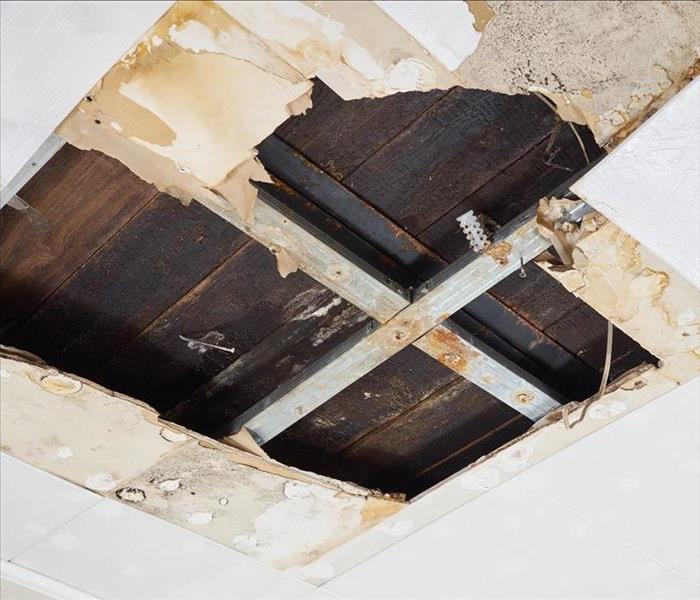 Roof damage in Bangor, PA
Roof damage in Bangor, PA
How a Winter Storm Can Damage Your Business
Following a severe winter storm, your Bangor, PA business building can suffer from damages to these areas.
Roof
Gutters
Windows
Interior
Although extreme weather can compromise the exterior, the following conditions can lead to interior devastation.
Snow
During the winter, a roof can collapse or crack if it cannot withstand the weight of snow and ice that doesn't run off or melt. Small cracks or fissures can also cause melting snow and ice on a roof to leak into a building leading to potential flooding and mold development.
Ice
Snow and rain can freeze after it rolls into gutters. When these channels cannot direct additional water off a roof, it can accumulate across its surface and enter a building through small cracks and fissures that not be apparent. The resulting moisture within a building's walls and framework can ultimately promote mold growth that can spread to other areas.
Wind
Strong wind from a winter storm can deposit heavy objects on a roof, send debris crashing through windows or cause trees to fall on your building. When heavy rain or snow accompanies wind, gallons of water can enter a building through wind-damaged areas. The result can be widespread flooding, electrical fire, and mold development.
Temperature
As winter temperatures drop, water in uninsulated pipes can freeze. Icy water particles can expand, forcing unfrozen water toward the interior faucet faster than the pipe can accommodate it. Immense water pressure can cause the pipe to burst, causing gallons of water to flood your business. It is essential to prevent mold formation by extracting excess water quickly.
Winter storm damage can happen to your building's exterior and interior, even if you keep up with maintenance and repairs. Fortunately, you can count on a Bangor, PA disaster restoration company to help clean up, restore and prevent further damage so that you can focus on running your business.
Should You Replace the Supply Lines in Your Bathroom?
6/4/2020 (Permalink)
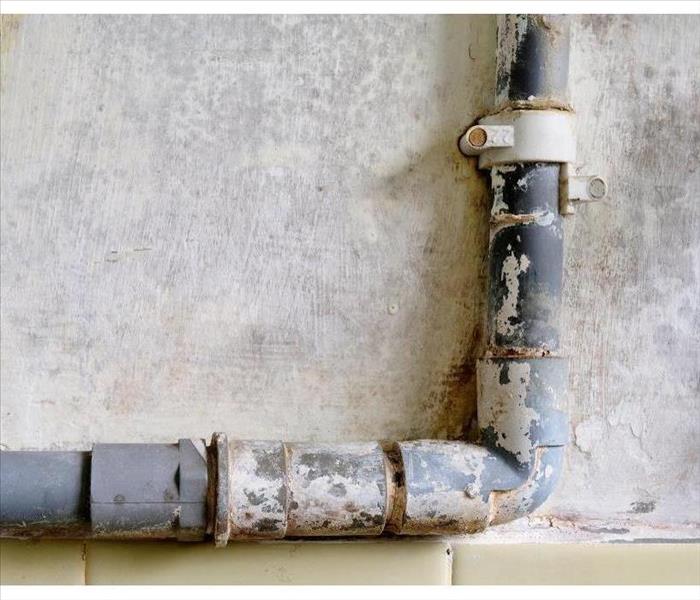 To avoid supply line damage, inspect your pipes to see if they are made of long-lasting materials
To avoid supply line damage, inspect your pipes to see if they are made of long-lasting materials
The water supply line is the piping that connects the plumbing in your home in Pen Argyl, PA to your groundwater wall or the municipal water main. Since all of the water flowing into the house runs through this line, it is a key plumbing component. Supply line damage can cause serious flooding, so it's important to keep your system maintained. A little preventive action now can save you a lot of money in water damage repair in the future.
What Can Cause Problems With the Supply Line?
Supply line damage can be caused by a number of different things. Contact a professional if you suspect damage.
The roots from large trees can force their way into a water line, blocking water flow and causing a supply line leak.
Pipes made of iron were once popular in homes, but since they can rust and become corroded and over time, they are no longer used in construction. If you have an older home, you should have a professional inspect your water line and replace any iron pipes.
Impurities in the water can cause minerals to build up, creating a clog.
Sewage in the floor drain will plug the pipes and create a bathroom leak.
The only paper product you should flush down the toilet is toilet paper. Facial tissues and paper napkins don't compose as quickly as toilet paper, so they can plug up the system.
What Materials Can Be Used for Supply Lines?
Water lines can be made with different materials. Because steel-braided pipes have a lifetime warranty, they are a smart choice. They are also flexible and easy to install. Copper pipes are also used because they are sturdy and long-lasting, but since they are expensive, they aren't as widely used. Plastic lines will only last for 5 to 8 years, so they must be replaced frequently.
To avoid supply line damage, inspect your pipes to see if they are made of long-lasting materials. If they aren't, you should have them replaced as soon as possible.
How To Limit Damage From a Broken Pipe
5/10/2020 (Permalink)
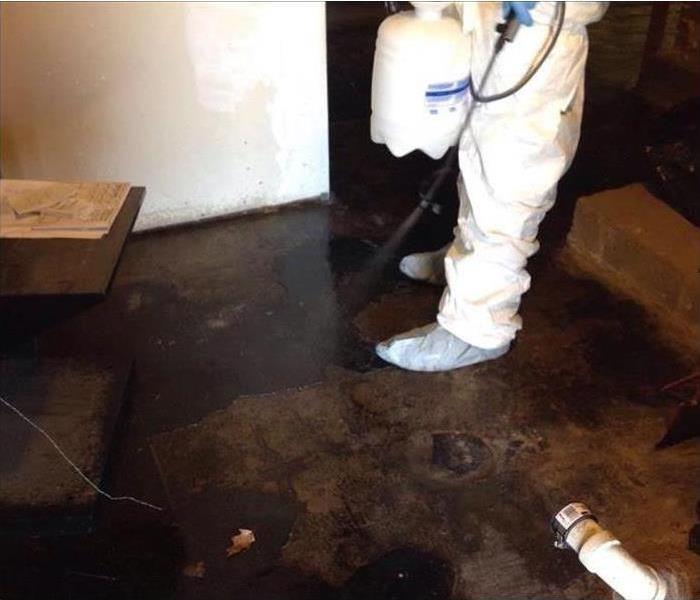 Commercial water restoration in Easton, PA
Commercial water restoration in Easton, PA
Bursting pipes are among the most common causes of commercial water damage. The extent of damage depends on the flow rate and how long water continues to be supplied to the location of the break. It is important to act quickly to stop the flow and contain water. The following measures are helpful for limiting the damage caused by a broken pipe.
Shut Off the Water Supply
The extent of damage depends on the flow rate of a pipe until water is no longer being supplied to the location of a break. Here are the flow rates for several common pipe diameters:
- A half-inch pipe releases 50 gallons per minute
- A one-inch pipe releases 210 gallons per minute
- A two-inch pipe releases 850 gallons per minute
Even a few minutes of uninterrupted flow may require the extraction of hundreds or thousands of gallons of standing water. Turning off the water supply will slow and stop the flow.
Contain Water Damage
If more than one occupant is present at the time of a pipe break, one person should shut off the water supply while the other takes measures to contain or limit damage. It may be possible to use containers to collect water from bursting pipes or try to protect contents from damage.
Schedule a Repair
A commercial property owner should contact a plumber to fix broken pipe. A restoration company that specializes in water damage in Easton, PA should also arrive on site in a timely manner to assess and mitigate damage.
These measures are helpful for dealing with bursting pipes at a commercial building in Easton, PA. Shutting off the supply of water to a broken pipe is the most important step that can be taken to limit damage. Building owners and managers should rely on licensed plumbers and trained restoration professionals to fix the problem and any resulting damage.
How To Protect Your Home From Secondary Damage
2/18/2020 (Permalink)
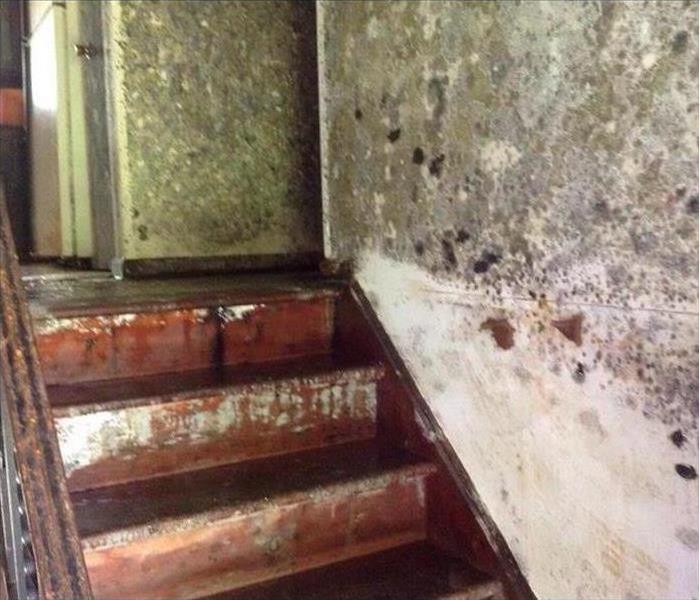 Secondary damage in a Bangor, PA home
Secondary damage in a Bangor, PA home
When dealing with the aftermath of floods or water leakage in Bangor, PA, it's crucial to take immediate action and prevent secondary damage. Whether your home has suffered a small leak or seen a large issue with an appliance that caused an indoor flood, cleaning the mess correctly can prevent the growth black mold.
What Creates Secondary Damage?
Secondary water damage occurs when a water issue isn't tended to promptly. Couple this neglected water with high humidity, and it creates the perfect recipe for a structural building fiasco. If secondary damage is left alone long enough, it can lead to the following expensive problems:
- Bending and buckling of hardwood floors
- Black mold
- Destroyed Vinyl
- Rotting and crumbling drywall
What Steps Can You Take To Protect Your Property?
The safest way to deal with most water damage, particularly if black or gray water are involved, is to enlist the help of a water restoration company. A professional cleanup company can offer many benefits, but the most prominent is the ability to use specialized equipment in the remediation process. These tools can find hidden moisture and quickly remove it from a particular host.
An experienced water damage mitigation company will also take the time to closely monitor the drying process in situations that involve pooling water and high humidity. This step can mean the difference between an easy fix and deeper issues that can become costly. These companies not only clean any affected areas, but they also take the time to deodorize your home.
Life is wonderful, yet unpredictable. No matter how much planning you do, no one is fully immune to severe weather, failing appliances and other unexpected events that can lead to water in your home. If you take immediate action, however, and hire qualified professionals in Bangor, PA, to safely clean and restore your home, you can lessen your risk of secondary damage and black mold.
When Should You Call a Certified Restoration Company for Water Damage?
2/3/2020 (Permalink)
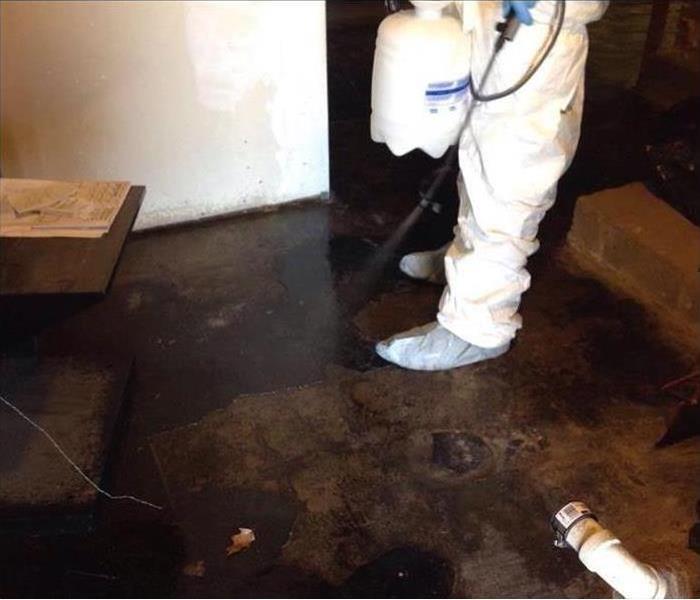 Cleaning and sanitizing a commercial facility in Pen Argyl, PA
Cleaning and sanitizing a commercial facility in Pen Argyl, PA
Steps To Take If You Have Water Emergency
When a water intrusion disaster strikes your business in Pen Argyl, PA, it’s easy to panic. Even when you’re fully insured, it’s going to be a challenging time, but there are proactive things you can do to dramatically ease the tension. From a pipe burst cleanup to a major storm repair, a professional restoration company can turn things around relatively quickly.
There are a few things to do in a water emergency, typically in this order:
- Safety first! Do whatever’s necessary to get and keep people out of harm’s way.
- Take any immediate steps to reduce further damage, such as shutting off water.
- Call a top restoration company for advice.
- Call your insurance agent.
Your First Steps
First, get your employees and customers away from any danger. If a major storm is approaching, tell non-essential employees to stay home for now. If the problem is a broken pipe, shut off the water. If you don’t know where that is, call the water company or your restoration company. Storm damage may require tarping and boarding.
Next, Call Your Cleanup and Restoration Company
You may be tempted to call the insurance company first, and broadly speaking, it’s alright to do so. However, experienced restoration companies can usually help you deal more effectively with an insurance agent and make sure you get the coverage you’ve paid for. They can also immediately begin the drying process with advanced air moving equipment.
Most Significant Commercial Water Intrusion Damage Will Require Professional Restoration
For a black water intrusion, only a sewer cleanup company will have the knowledge to fully sanitize the affected area. Even a simple pipe burst cleanup in Pen Argyl, PA, can have major complications, such as hidden structural damage and fungus growth.
SERVPRO is an IICRC-certified commercial restoration company that works closely with insurance agents to restore your business and get it fully operational quickly. They have specialized equipment and certified inspectors to find hidden water damage and prevent dry rot, which attracts wood-boring insects. Once they are involved, flooding, water damage from fire control and a pipe burst cleanup will be restored “Like it never even happened.”
Winter Weather Water Damage
12/2/2019 (Permalink)
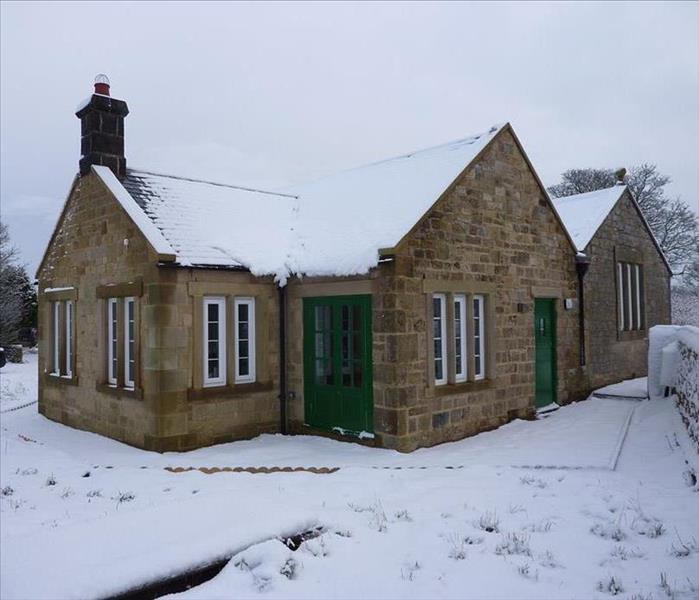 Snow covered house
Snow covered house
With the impending wintry mix that is expected this week in the Lehigh Valley, we figured that it would be a good chance to remind people of the most common water damage events that can happen due to cold weather and snow. For many in the US, the thought of getting home water damage from a cold snap doesn’t even register on their radar. But the truth is, any home can be susceptible to cold weather.
Ice dam formations on your roof
This is more common in colder climates where snow and cold weather tend to stick around throughout the winter. But ice dams cause a significant amount of water damage each year and can oftentimes becomes a black mold damage problem as well if left untreated. There’s a number of different techniques people apply to try and rid themselves of existing ice dams, but the truth is these can actually hurt your roof and cause more lasting long term damage. So do yourself a favor and read up on the subject so you don’t have to deal with water damage from ice dams.
Roof damages from high winds
Winter storms can often bring with them damaging winds that can rip shingles off your roof. Just a small amount of damaged or missing shingles can end up allowing a lot of water into your attic and/or home if rain or snow accompany the winds. If possible, have a roofing company check your roof after a strong wind storm just to make sure you don’t have any damages that could cause significant water damage.
Pipe bursts
By far the most common winter weather related water damage comes from frozen pipes that burst. It happens all the time when temperatures plunge. If you live in a colder climate, it usually happens when an exterior hose spigot or other pipe in the crawlspace/basement is exposed to the elements. Make sure your pipes are insulated or you’re at risk of some serious flooding issues!
Snowmelt
Melting snow can impact any home, whether it has a basement, crawlspace, or a slab foundation. If enough snow ends up piling up next to your foundation, it’s going to create a lot of water once it melts. Hopefully when it does melt, your lawn slopes away from your house but if not you could end up with hundreds of gallons of water lurking next to your house. With that much water, over time it’s going to soak into and through your foundation and cause damage inside your property!
While these certainly aren’t the only way hazardous winter weather can cause costly water damage, they are the most common causes we see each winter. So like we always say on this blog, an ounce of prevention is worth a pound of cure. Water damage costs can be high, and many types of damage aren’t covered by homeowner’s insurance policies. So it’s safest to take preventative steps on your own to make sure you greatly reduce the chances you end up with a problem on your hands!
Call SERVPRO of Easton, Bethlehem & Whitehall at 800-455-9453 this winter!
How to Prevent Frozen Pipes and What to Do if They Freeze Anyway
10/15/2019 (Permalink)
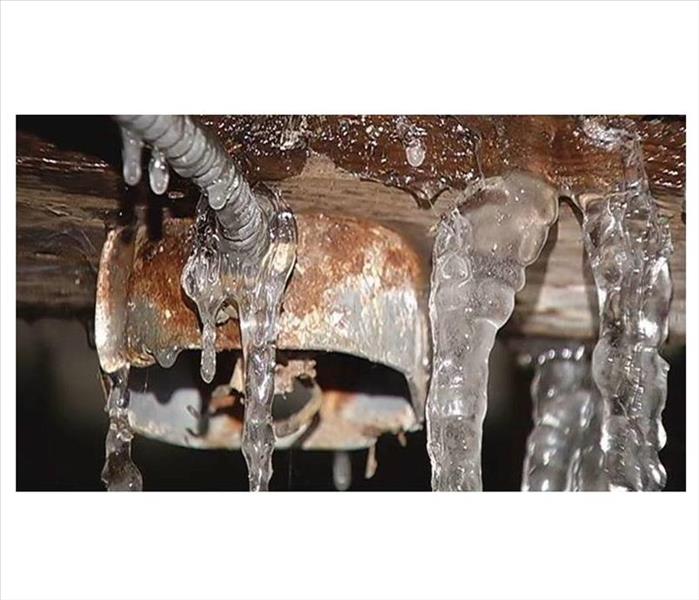 Prevent Your Pipes from Freezing
Prevent Your Pipes from Freezing
Brrrr it’s cold in here! There might be some frozen pipes in your house this year! Frigid winter temperatures can cause pipes to freeze – or even burst. Do you know how to tell if pipes are frozen? Here are some tips to help prevent frozen pipes and a list of suggestions for you to follow if they do freeze.
SYMPTOMS of Frozen Pipes
One of the earliest signs of a frozen pipe is when no water comes out of your faucet when you turn it on. If you notice that, head first to the basement and check to see that the water is still turned on and that you don’t have a leak. Once you’ve confirmed these two things, continue your inspection to make sure one of your pipes has not burst.
If your search reveals that your pipes are frozen but none have ruptured, you have two choices:
- Call a plumber to help thaw your frozen pipes. This is a good idea if you don’t think you can safely thaw the pipes yourself, you don’t know where the frozen pipes are or you can’t access the frozen area.
- Attempt to thaw the frozen pipes yourself. Be aware this option can be dangerous if not done correctly.
How to FIX Frozen Pipes
If you attempt to thaw the frozen pipes yourself, keep the following tips in mind:
- Keep your faucet open. Water and steam will be created during the thawing process, and your pipes need an opening to discharge this. Keeping the faucet open also allows for moving water to run through the pipe, which will expedite the thawing process.
- Apply heat to the section of the pipe that is frozen. This can be done by wrapping an electronic heating pad around the pipe, heating the area with a hair dryer or both. If you lack either of these items, using towels soaked in hot water will help as well.
- Know what not to do. Never use a blowtorch, propane or kerosene heaters, a charcoal stove or any other open flame device to thaw your frozen pipes. You should also avoid using a space heater unless you are sure the area is clear of any flammable material.
- Continue applying heat until water flow returns to normal. Once you have successfully thawed the pipe, turn on other faucets in your home to check for any more frozen water pipes.
- Take swift action if the frozen pipes are located inside an exterior wall. Cut a hole in the wall toward the inside of the house to expose those pipes to warmer air.
How to PREVENT Frozen Pipes
While we can’t control the weather, there are things we can do to prevent pipes from freezing. To prevent pipes from freezing and causing major damage, follow these steps:
- Drain water from pipes that are likely to freeze. This includes your swimming pool and sprinkler water supply lines.
- Disconnect any hoses from the outside of your home, drain the hoses and store them in the garage. Make sure to close the indoor valves supplying these outdoor access points.
- Insulate the area around vents and light fixtures. This helps prevent heat from escaping into the attic.
- Seal any wall cracks. Be sure to pay careful attention to the areas around utility service lines.
- Open kitchen cabinets. This allows the warm air to circulate around the pipes.
- Keep the garage doors closed to protect water lines.
- Allow your faucets to drip cold water on the coldest days. The movement will make it harder for the water to freeze.
- Keep your thermostat at the same temperature day and night. Never let it fall below 55 degrees Fahrenheit when you leave your home.
- Ensure you have proper seals on all doors and windows.
- Place a 60-watt bulb in areas where you’re concerned about pipes freezing. Make sure there are no combustible materials near the bulb.
Call SERVPRO of Easton, Bethlehem & Whitehall if you experience frozen pipes this winter season! 800-455-9453
Where to Look for Mold in Your Home
9/23/2019 (Permalink)
Mold can grow virtually anywhere—in any room of any house, in any commercial building and in any storage room. That said, some areas are more prone to mold problems than others. Knowing where to look for mold can help you detect, eliminate and prevent the problem.
Here are some common places you will find mold
- Basements: Flooding, leaks, condensation, poor ventilation… The basement tends to be very moist, especially if you have had any flooding down there. Concrete floors in basements are a great place for mold to grow, as are the corners of your walls. The floor being cooler than the humid air causes condensation, which leads to moisture, causing mold.
- Kitchens: Cooking, washing, inefficient exhaust fans…
- Bathrooms: Showering, steam, leaks, inefficient exhaust fans… If you are not cleaning, and allowing your shower to dry often enough, if you are not drying your floors after you step out of the shower, and if you are not allowing air to circulate your washroom during, and after you shower, that can all cause mold to grow. The steam from your shower makes the perfect home for mold; it is so warm, and damp. When you finish showering and close the door behind you, not allowing it to air out, not only will your washroom smell like a wet towel, but it greatly facilitates the growth of mold.
- Attics: Poor ventilation, insufficient air circulation, roof damage…
- Crawlspaces: Leaks, moisture intrusion, poor ventilation… Your crawl space is usually dusty, which feeds the mold, and damp, which the mold needs to survive. So make sure you don’t neglect your crawlspace, every once in a while, go check it out, make sure it is clean, get any dust out of there, and take a good look at the corners, the walls, the ceiling, and the floor.
- Laundry rooms: Washing, inefficient exhaust fans…
- Air Conditioners: Leaks, moisture, poor ventilation… Another place that can cause mold in your home is your air conditioner. They are perfect for helping mold to grow. They cause a difference in temperature, which results in condensation, and they circulate dusty air. Make sure that if you have an air conditioner, you have clean, mold reducing filters, and you check it regularly for any signs of mold. If you see any mold on it, shut it off, put on a mask, to avoid breathing the mold spores in, and clean it thoroughly with a rag or wet vacuum, and mold cleaner.
Despite your best efforts, mold problems aren’t always visible–sometimes they spread behind walls and ceilings or underneath floorboards. This is often the case when there’s a crack in your home’s foundation, a leaky pipe or some other type of water intrusion. That’s why you should also keep an eye out for mold on drywall, carpets, curtains, wallpaper, wood, furniture, food, plants and soil.
If you find mold in your home, give SERVPRO of Easton, Bethlehem & Whitehall a call to make it “Like it never even happened.” 800-455-9453
Psychro-WHAT? The Science Behind Structural Drying
9/19/2019 (Permalink)
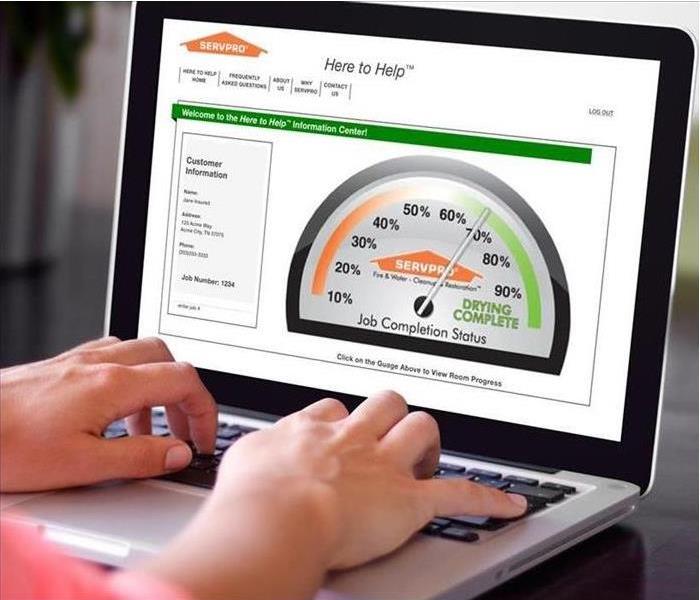 SERVPRO shares the science behind drying
SERVPRO shares the science behind drying
Psychrometry is the study of the air and its properties. The properties of temperature, humidity, vapor pressure and dew point are measured to evaluate air conditions in the structure, enabling a SERVPRO® Franchise Professional to create the proper atmosphere for more efficient drying.
Water can damage materials in two ways: first, by absorption through direct contact with water; and second, absorption of moisture from the air. Measuring the moisture content of the air is critical to the drying process.
At SERVPRO of Easton, Bethlehem & Whitehall we employ several tools and techniques to aid the drying process and accelerate it as well. Our most important asset is our people and the knowledge they bring to the damaged property. We are highly trained teams of IICRC Certified Water damage restoration professionals. This means when you call SERVPRO of Easton, Bethlehem & Whitehall you are getting the highest quality of professionals to address any size disaster. We are very proud to be a leader in the emergency services and disaster restoration industry.
If you ever find yourself in need of Water Damage Restoration services, call SERVPRO of Easton, Bethlehem & Whitehall at 800-455-9453
What to Do When Making an Insurance Claim
9/18/2019 (Permalink)
What To Do When Making a Flood Insurance Claim
Most homeowners’ insurances do not offer flood coverage. However, if you have a separate flood policy for your home, then you will want to file an insurance claim if your home has been damaged. The process can sometimes be frustrating or confusing, so use the following tips to get through it more smoothly.
Call Your Insurance Agent
The first step in filing a flood claim is calling your insurance agent. In some cases, the company can deny your claim if you have waited too long to contact them. Getting the process started right away will prevent this.
Take Pictures
After you have contacted your agent to begin the process, you should take photos of any areas of the house that have been flooded. Be sure to photograph any affected items as well. This will help the insurance company determine the extent of the damage. Keeping a list can be helpful as well.
Set Aside Affected Belongings
Once you have taken pictures and documented the damage, you don’t need to wait for the insurance adjuster to arrive to begin moving your items. If you allow them to sit in the water, the damage will only worsen, so you should relocate them to a dry area quickly.
Prevent Additional Damage
If the insurance company does not believe that you have taken the necessary steps to prevent further damage, this can affect your flood claim. It is a good idea to call an emergency cleanup company like SERVPRO of Easton, Bethlehem & Whitehall to do repairs, but you can start on remediation before they arrive. Along with moving affected items, you can board up areas and place tarps to prevent the water from spreading.
Making a flood claim may not always be the simplest process, but there are things you can do to make it easier on yourself. Following this advice will help move it along more quickly and ensure you get the most that you can from your policy. You can call SERVPRO of Easton, Bethlehem & Whitehall anytime at (800) 455-9453.
If you ever find yourself in need of Water Damage Restoration services,
call SERVPRO of Easton, Bethlehem & Whitehall at 800-455-9453
The 5 Most Common Causes of Water Damage in your Lehigh Valley Home
9/18/2019 (Permalink)
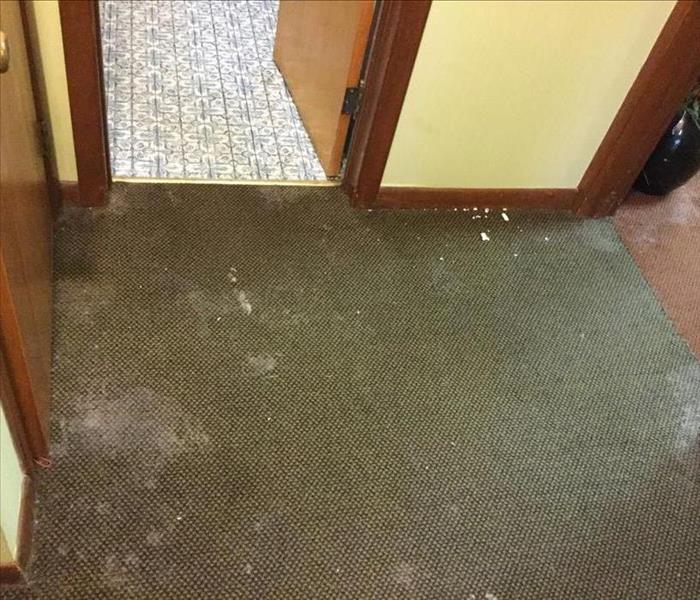 Water Damage happens quickly. Call SERVPRO of Easton, Bethlehem & Whitehall when disaster strikes.
Water Damage happens quickly. Call SERVPRO of Easton, Bethlehem & Whitehall when disaster strikes.
As a homeowner, you should be aware of all the possible things that could happen to your home. Storm damage, wind damage- and, most frequent of all, water damage. As homeowners, you think things like this would never happen to you, but if they, everyone should be prepared. Below are the 5 most common causes of water damage in a home and advice to help you be more prepared.
- Air Conditioner- your air conditioner might seem to be working just fine, but it’s important to get regular service checks (at least once a year) to make sure nothing is malfunctioning behind the scenes. Your A/C removes moisture from the air and sometimes that moisture builds up. If not properly drained, that water could be slowly leaking into your home- potentially ruining the flooring and drywall and, in many cases, introducing mold.
- Dishwasher- dishwashers are another possible culprit of water damage in your home. Your dishwasher can cause water damage if not properly sealed, meaning the latch is broken, or if it was loaded with the wrong soap. Make sure that any leaks are immediately addressed and that your dishwasher is repaired or replaced ASAP, so you can avoid costly damage to you kitchen
- Washing Machine- perform regular checks on your washing machine, inspecting beneath the unit as well as behind it. Make sure all fittings are securely connected, and that the underbelly of the washing machine isn’t leaking any water beneath the unit.
- Leaking Pipes- it might be obvious, but water damage in a home is often caused by leaky pipes. A leak in one place in your home could signify leaks in other areas, too. If you notice spikes in your water bill, a leak is likely present and needs to be addressed before additional damage is caused to you foundation, flooring, and other areas in a home.
- Clogged Drains- clogged drains aren’t just annoying, they also cause water damage (and mold growth) if left unchecked. If your toilet is clogged, it means that not only can you NOT use the toilet, but you will likely also experience water backing up into the shower, sinks, or bathroom floor. Sewer water is extremely dangerous because it contains raw sewage and bacteria, and must be cleaned by a professional. If the kitchen sink is backing up, you may experience sink overflow and subsequent damages to you kitchen floor and cabinetry.
If you notice any signs of water damage in your home, call SERVPRO of Easton, Bethlehem & Whitehall to make it “Like it never even happened.” 800-455-9453
Saving Water Damaged Electronics
11/26/2018 (Permalink)
Water-damaged electronics can present a serious hazard. Do not attempt to turn on or operate any electrical device that you suspect has been damaged by water. SERVPRO of Easton, Bethlehem & Whitehall can coordinate the restoration of your electronics, including TVs, DVD players, computers, tablets, cell phones, and more.
The Key To Electronic Cleanup
The key to restoring electronics is taking prompt action to prevent further damage. SERVPRO of Easton, Bethlehem & Whitehall starts by cleaning the exterior of your electronic devices to help stop further corrosion and damage. With us, your electronics will be cleaned and inspected by a qualified electronics technician.
Cleaning Up Corrosion
When it comes to cleaning up corrosion after water damage, be careful. If you don’t use proper tools and techniques you can further damage your water-damaged electronic devices. You could also potentially injure yourself. Remember: electronic devices and liquids generally don’t mix. Any time you apply a liquid cleaning solutions to an electronic device, you need to be cautious. SERVPRO of Easton, Bethlehem & Whitehall recommends that the average consumer never attempt to repair a water-damaged electronic device without professional assistance. When in doubt, take your device to a professional. If you are confident about cleaning up corrosion on your water-damaged electronic device by yourself, please keep these tips in mind:
1. Keep safety first
If you’re standing in water or your clothes are wet please remove yourself from any potential shock hazard before even thinking about retrieving a submerged or soaked electronic device. If the device is still on, turn it off. If possible, rotate and shake the electronic device to try to drain out any fluid.
2. Always remove any batteries or power connectors.
This not only prevents harm to you, but also prevents any short-circuiting of your electronic device. By doing this, you will also be exposing extra connectors that may already have corroded, so exercise caution. A shorted battery may be a fire and/or chemical hazard. If you see or feel any heat, smoke, steam, bubbling, bulging, or melting avoid handling the electronic device.
3. Look for white or green “crusty” areas on the device.
You may find them on the battery connectors, charging ports, SIM card connectors, or any other major metal connectors on the device.
4. Use cotton swabs and a cleaning solution such as isopropyl alcohol.
You can also use baking soda and water or vinegar to clean corrosion. Gently apply the solution to the affected area and wipe back and forth until you’ve removed the corrosion. If necessary, leave some solution on the corroded area and wipe it off later.
5. Dry your electronic device with a soft cloth or a hair dryer on a cool setting.
Do not use heat to dry out your device. Make sure your device is dried extremely well before attempting to replace the battery and turn the device on. Any water left in the device could cause additional water damage.
6. Take special care with electronic circuit boards.
If you think water or any liquid has reached an electronic circuit board take the device apart carefully. Follow the instructions and remember the order of the disassembly so you can put the device back together later. Soak up any remaining liquid on the circuit board with a lint-free cloth. Don’t use paper products (they could leave lint or scratch the board). Avoid rubbing any cloth on the circuit board because that might scratch or dislodge parts. Place the cloth over the board and press gently. This will soak up the liquid. Remove the worst of any remaining particles by brushing with a toothbrush. This includes any globs of dried liquid. You don’t need perfection at this stage. Then remove any dust or loose pieces of dried liquid by spraying the board with compressed air. Spray in one direction in quick bursts, since the canister can become extremely cold if used for longer sprays. Rinse the circuit board with clean or distilled water to remove any sticky materials. If your circuit board was wet by clean water and you didn’t have to remove dried materials, you may be able to skip this. Pat the board gently with a cloth to remove the majority of the moisture and allow it to dry completely. Clean any residue off the circuit board using a cotton swab. Moisten the cotton swab in isopropyl alcohol. Do not use a dripping wet swab. Swab gently in stubborn areas and be careful not to upset the components. The alcohol should take care of most of the work without rubbing.
7. Cross your fingers
When you try to repair a water-damaged electronic device there are no guarantees. The water-damage or corrosion may be permanent. These steps improve your chances of repairing it, but in the end you just have to cross your fingers and hope for the best.
Call us today! 800-455-9453
Water Shut Off
11/19/2018 (Permalink)
In an emergency you may have to shut off the water to your home. For example, freezing or thawing may cause a water pipe to break. Water pipe breaks are also common with most types of natural disasters (winter storms, hurricanes, tornadoes, and more). Broken water pipes can lead to electrical hazards, long-term wood rot, long-term mold, or even drowning.
Where’s The Water Shut-Off Valve?
1. Look for the water shut-off valve where the water line enters your house. In warmer climates the shut-off valve may be outside your home where the water line meets your home’s exterior. But in most climates the water shut-off valve is just inside the house where the water line enters through your home’s foundation or exterior wall. Scott Finazzo, author of The Neighborhood Emergency Response Handbook, says that if your water comes in through a ground well the valves on either side of the pressure tank should both be shut off.
2. Often the water shut-off valve is a quarter-turn ball valve. If that’s what you have, turn the valve a quarter of a turn until it’s perpendicular to the water pipe. Or your home may have a round handle that you turn clockwise until you can’t turn it anymore. Don’t have a master shut-off value in your home? Have one installed.
If You Have Water Damage Call SERVPRO Of Easton, Bethlehem & Whitehall At (800) 455-9453
3. Another water shut-off option is closing the municipal water meter shut-off valve. This valve, if you have municipal water, typically is in your front or side yard. Look for a round metal lid or box close to your property line. It’s often 24 to 48 inches from the curb or fence line.
If your water meter has a round metal lid use a wrench or pliers to rotate the lone nut on the lid counterclockwise. This will release the latch and you can open the lid. Another type of metal lid requires a screwdriver. Turn the lid until the tabs line up with the gaps and you can lift the lid off. A third type of water meter lid is square or rectangular. You can pry it open with a screwdriver or pry bar.
Don’t reach into the meter box until you inspect the area for debris and rodents. If the box is old and covered with a lot of growth you may want to wear gloves. Once inside the municipal water meter box you’ll need pliers or a specialty tool to turn the valve. Turn it until it’s perpendicular to the water pipe.
If You Have Water Damage Call SERVPRO Of Easton, Bethlehem & Whitehall At (800) 455-9453
Shut-Off Valves For Single Rooms
Sometimes you only need to shut off the water to one room. Most newer houses have shut-off valves at every sink and toilet. Your water heater may have several shut-off valves. If your issue is one leaking sink just shut off water to that sink. If you know the water heater is leaking just shut the valves to it off.
Water Damage Can Be Disruptive
11/5/2018 (Permalink)
Water leaks within a home or business can seep into carpet, flooring, baseboards, and walls while moving throughout the structure. SERVPRO of Easton, Bethlehem & Whitehall Professionals understand how disruptive water damages can be for a family or business. Water leaks in a business can not only disrupt the facility, but also can interrupt day to day business functions, which could possibly close the business and affect revenues.
Timely mitigation is key to the restoration process. Quick response time helps ensure that damage is contained and the restoration process begins promptly. This saves on the amount of damage, cost of claims, and assists in reducing losses from business interruption due to a loss. Timely and proper water mitigation will also help keep mold from developing which could cause people to become ill! SERVPRO Professionals will be able to identify water regardless of where it hides. Your local SERVPRO Franchise Professionals cover the Charleston, WV, and surrounding areas. We offer 24-hour emergency response from our trained professionals to help make it "Like it never even happened."
Leak Prevention Tips
- Check roof for deterioration.
- Check gutters and downspouts.
- Check basements and crawl spaces for moisture.
- Check appliances in kitchens, break rooms, and cafeterias.
- Check sinks and toilets in bathrooms.
- Check HVAC for leaks and blockages.
Call us today! 800-455-9453
Saving Water Damaged Electronics
11/5/2018 (Permalink)
Water-damaged electronics can present a serious hazard. Do not attempt to turn on or operate any electrical device that you suspect has been damaged by water. SERVPRO of Easton, Bethlehem & Whitehall can coordinate the restoration of your electronics, including TVs, DVD players, computers, tablets, cell phones, and more.
The Key To Electronic Cleanup
The key to restoring electronics is taking prompt action to prevent further damage. SERVPRO of Easton, Bethlehem & Whitehall starts by cleaning the exterior of your electronic devices to help stop further corrosion and damage. With us, your electronics will be cleaned and inspected by a qualified electronics technician.
Cleaning Up Corrosion
When it comes to cleaning up corrosion after water damage, be careful. If you don’t use proper tools and techniques you can further damage your water-damaged electronic devices. You could also potentially injure yourself. Remember: electronic devices and liquids generally don’t mix. Any time you apply a liquid cleaning solutions to an electronic device, you need to be cautious. SERVPRO of Easton, Bethlehem & Whitehall recommends that the average consumer never attempt to repair a water-damaged electronic device without professional assistance. When in doubt, take your device to a professional. If you are confident about cleaning up corrosion on your water-damaged electronic device by yourself, please keep these tips in mind:
1. Keep safety first
If you’re standing in water or your clothes are wet please remove yourself from any potential shock hazard before even thinking about retrieving a submerged or soaked electronic device. If the device is still on, turn it off. If possible, rotate and shake the electronic device to try to drain out any fluid.
2. Always remove any batteries or power connectors.
This not only prevents harm to you, but also prevents any short-circuiting of your electronic device. By doing this, you will also be exposing extra connectors that may already have corroded, so exercise caution. A shorted battery may be a fire and/or chemical hazard. If you see or feel any heat, smoke, steam, bubbling, bulging, or melting avoid handling the electronic device.
3. Look for white or green “crusty” areas on the device.
You may find them on the battery connectors, charging ports, SIM card connectors, or any other major metal connectors on the device.
4. Use cotton swabs and a cleaning solution such as isopropyl alcohol.
You can also use baking soda and water or vinegar to clean corrosion. Gently apply the solution to the affected area and wipe back and forth until you’ve removed the corrosion. If necessary, leave some solution on the corroded area and wipe it off later.
5. Dry your electronic device with a soft cloth or a hair dryer on a cool setting.
Do not use heat to dry out your device. Make sure your device is dried extremely well before attempting to replace the battery and turn the device on. Any water left in the device could cause additional water damage.
6. Take special care with electronic circuit boards.
If you think water or any liquid has reached an electronic circuit board take the device apart carefully. Follow the instructions and remember the order of the disassembly so you can put the device back together later. Soak up any remaining liquid on the circuit board with a lint-free cloth. Don’t use paper products (they could leave lint or scratch the board). Avoid rubbing any cloth on the circuit board because that might scratch or dislodge parts. Place the cloth over the board and press gently. This will soak up the liquid. Remove the worst of any remaining particles by brushing with a toothbrush. This includes any globs of dried liquid. You don’t need perfection at this stage. Then remove any dust or loose pieces of dried liquid by spraying the board with compressed air. Spray in one direction in quick bursts, since the canister can become extremely cold if used for longer sprays. Rinse the circuit board with clean or distilled water to remove any sticky materials. If your circuit board was wet by clean water and you didn’t have to remove dried materials, you may be able to skip this. Pat the board gently with a cloth to remove the majority of the moisture and allow it to dry completely. Clean any residue off the circuit board using a cotton swab. Moisten the cotton swab in isopropyl alcohol. Do not use a dripping wet swab. Swab gently in stubborn areas and be careful not to upset the components. The alcohol should take care of most of the work without rubbing.
7. Cross your fingers
When you try to repair a water-damaged electronic device there are no guarantees. The water-damage or corrosion may be permanent. These steps improve your chances of repairing it, but in the end you just have to cross your fingers and hope for the best.
Call us today! 800-455-9453
Water Damage - Category and Classes
9/25/2018 (Permalink)
Do you know what is the water category of this loss?
Category 1 originates from a sanitary source and poses no substantial risk from dermal, ingestion, or inhalation exposure. It is important to note, it may not always remain clean after it comes into contact with other surfaces or materials.
Category 2 contains significant contamination and has the potential to cause discomfort or sickness if contacted or consumed. It may contain potentially unsafe levels of microorganisms or nutrients for microorganisms, as well as other organic or inorganic matter (chemical or biological).
Category 3 is grossly contaminated and may contain pathogenic, toxigenic or other harmful agents. Such water sources may carry silt, organic matter, pesticides, heavy metals, regulated materials, or toxic organic substances.
Time and temperature can also affect the quality of water, thereby changing its category. *Refer to the IICRC S500 for complete definitions.
Class 1 is the least amount of water, absorption and evaporation. It affects only part of a room or area, or larger areas containing materials that have absorbed minimal moisture. Little or no wet carpet and/or cushion is present.
Class 2 involves a large amount of water, absorption and evaporation. It affects at least an entire room of carpet and cushion (pad). Water has wicked up walls less than 24 inches. There is moisture remaining in structural materials and substructure soil.
Class 3 involves the greatest amount of water, absorption and evaporation. Water may have come from overhead. Ceilings, walls, insulation, carpet, cushion and subfloor in virtually all of the entire area are saturated.
Class 4 relates to specialty drying situations. Typically, there are deep pockets of saturation, which require very low specific humidity. These types of losses may require longer drying times and special methods.
*Refer to the IICRC S500 for complete definitions.
For your water mitigation and restoration needs call the professionals at SERVPRO of Easton, Bethlehem & Whitehall (800) 455-9453
Highly Trained Restoration Specialists
Our SERVPRO Professionals are highly trained in property restoration. From initial and ongoing training at SERVPRO's Corporate Training Facility to regular IICRC industry certifications, our Professionals are equipped with the knowledge to restore your property. Our SERVPRO training program includes, but not limited to, the following:
- IICRC Training
- Employee Certification Training
- e-Learnings
- Continuing Education Classes
Do You Know What To Do When Floods Happen?
9/25/2018 (Permalink)
When a disaster happens, it’s difficult to know what steps to take. But when you’re facing a flood, doing the right things as soon as you can makes a big difference. Check out our tips for what you should do – and what you shouldn’t do – if your property ever suffers water damage.
In a Flood, You SHOULD:
- Shut off your water. Locate the main shut off valve and turn it off (clockwise).
- Get rid of as much water as possible. Mop up any standing water and open the windows to help dry things out.
- Move furniture, carpets, and other belongings off the wet floors. Move valuables, carpets, and furniture out of standing water and off of wet spots. If any of the items are wet, set them down to dry with plenty of space between them – more space means more airflow, which will speed drying. Rugs should be hung up, but not over a railing or against a wall: the drying rug will just get the railing or wall wet.
- Open and air out all containers. Containers aren’t always watertight; if a box, bag, trunk, or other container is damp on the outside, make sure you unpack it completely and air out the contents.
- Dry clothing (unless dirty). Leaving clothes wet increases the chance of mold or mildew growth. If the clothing is dirty from dirty water, don’t dry it. Leave any delicate or specialty items for the professionals to handle.
Things To AVOID:
- Never use a vacuum on water. Household vacuums aren’t designed to suck up water – getting them wet can be a safety hazard.
- Don’t go near anything electrical. Outlets, plugs, and appliances are all off-limits after a flood. Just because you can’t see damage doesn’t mean all is well. Wait until an electrician has been able to determine safety.
- • Don’t go into rooms with sagging ceilings. A sagging ceiling is waterlogged and could fall at any moment. Call SERVPRO of Easton, Bethlehem & Whitehall as Soon As Possible
The sooner we get on scene, the better. With water damage, the first 24 hours are critical: if you call us right away you increase the chances that everything can be salvaged. The longer something is wet, the longer the water has to soak in, the harder it is to remove, and the more likely it is to become mold or mildew.
Aspects to Look at During Water Damage Restoration
9/20/2018 (Permalink)
SERVPRO Effectively Tackles Water Damage Regardless of the Source of the Water
Water damage restoration is not all about extracting water from a structure and ventilating the area so that drying can take place. Professionals in this area understand the drying theory and how to apply its principles to achieve the drying goal. So, do not make a mistake of thinking that placing drying equipment and spraying products are all that professionals do during the restoration process. We are going to look at the various aspects that professionals consider when attending to such incidents in the Lehigh Valley.
The amount of water in your property after a water damage event in Easton, Bethlehem, & Whitehall is also crucial. Our SERVPRO technicians start by determining its source - it can be black water, gray water, or clean water. Clean water does not contain waste products, and it is usually water from a treated source. It can come from faulty appliances, overflowing sinks, leaking roofs and burst pipes. Fewer health risks are associated with this category of water; though, it ceases to be clean once it flows across the soil. In most cases, carpets and pads exposed to clean water are salvageable.
Gray water is also known as category 2 water, and it carries waste products - minus human waste. If your washing machine malfunctions and overflows, the water it dumps on the floor is under this category. It may present health risks if a person drinks, touches, or experiences any form of contact. Our SERVPRO team thoroughly cleans carpets exposed to gray water and replaces saturated pads.
Category 3 water is known as black water - though it does not means the water must be black. It is majorly unsanitary water with much debris which exposes humans to health risks. Burst sewage back-ups and floodwater are examples of its sources. It is advisable to replace porous materials, pads, and carpets that are contaminated with black water.
At SERVPRO of Easton, Bethlehem & Whitehall, we respond immediately to storm, mold, fire, and water damage disaster. Call us at (800) 455-9453and let us make your property “Like it never even happened.”
Freeze Drying and Why You Should Care
8/21/2018 (Permalink)
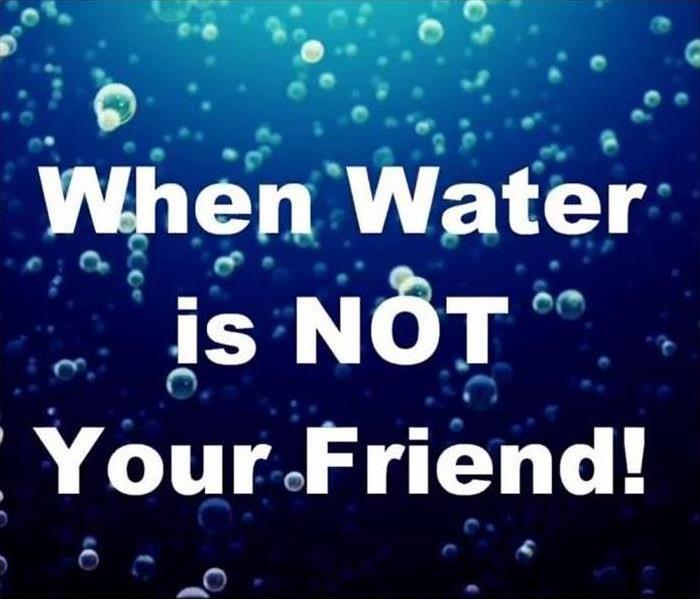 Water is not always your friend. Especially if you run an office that requires a lot of documents and secure information to be kept.
Water is not always your friend. Especially if you run an office that requires a lot of documents and secure information to be kept.
Do you have a lot of important documents in your office?
Is your office subjected to HIPAA regulations or client and patient confidentiality laws?
What is your plan for all those if you have a water damage event?
Did you know that SERVPRO of Easton, Bethlehem & Whitehall has a solution for that?
It starts with a relationship with your facility and an understanding about what the process is and how it works. Here is a snapshot. We need to have someone from your office that can assist with proper labeling of the boxes so none of the files are misfiled.
The next steps are critical and will ensure the largest number of documents survive.
Freezing Documents/Cold Storage
Where to find Cold Storage Facilities. Grocery Stores tend to have a vendor in their area that rents cold storage spaces to store their excess frozen goods until they are ready to be put on the shelf. These facilities regularly have extra space and will store documents as well. Price may vary depending on your location. However, the average rate around the country is roughly $4 a cubic foot per month. These facilities should be used primarily if you need Long-Term storage. SERVPRO Industries, Inc. also has cold storage available. Call and ask about available space and pricing. Documents should be sent to SERVPRO Industries, Inc. as soon as possible in order to minimize damage to documents and facilitate drying procedures to ensure efficient return.
Shipping
Any of the major shipping carriers (UPS, FedEx, USPS) will work for smaller orders. Overnight Shipping is a MUST. Whether the documents are frozen or not. It is crucial that we receive these documents as soon as possible in order to keep them frozen until they are ready to be cycled through the chamber. This prevents further damage and deterioration. Overnight shipping is most important when dealing with documents that have not been frozen PRIOR to shipping. The sooner we receive documents that have not been frozen the sooner we can freeze them and stop them from further damage/deterioration. Refrigerated Trucks and Trailers (Reefer Trucks) Reefer trucks come in many different sizes, ranging from 16’ box trucks all the way to 53’ tractor trailers. They can be rented from a lot of the major rental companies like Penske, and Ryder. There are even smaller rental companies all over the nation that rent reefer trucks. Reefer trucks work the best when dealing with larger quantities of documents. This is because it doubles as your cold storage as well as shipping! Once you have the truck packed, all you have to do is find a driver to drive it to us and we’ll handle the rest!
Benefits of Vacuum Freeze Drying
Vacuum Freeze drying
- Process in which an item containing moisture is frozen and dried using various vacuums and pressures to achieve sublimation.
- Sublimation is the direct conversion of a solid (Ice) into a gas (water vapor), without passage through a liquid stage. Take Dry Ice for example. Dry ice is made of Carbon Dioxide, not water. When dry ice is exposed to normal atmospheric conditions it begins to sublimate, it turns directly from its sold stage into its gaseous stage bypassing the liquid stage
Why Vacuum Freeze Drying?
Vacuum Freeze Drying is the most efficient and effective way to salvage water damaged documents. It is the only method that is approved by NARA (National Archives and Records Administration) and the GSA (General Services Administration). Other Methods such as dehumidification can alter the structure of the paper’s fibers and cause the papers to become more brittle and is not recommended by any means.
Other Services Provided Digitizing
With the new age of technology majority of people have begun digitizing their documentation rather than keeping the hard paper copies. However, businesses that have been around for a long time (Hospitals, Law Firms, State and Federal Governments) still have a surplus of paper documentation. Most of these businesses do not have the time to digitize these old files. In the event that these documents need to be salvaged, digitizing may also be a good option. It makes them easier to access as well as easier to store. Many businesses have storage facilities that are specifically for documents, or they subcontract the storage and upkeep to a company like Iron Mountain. This makes accessing a particular file very difficult and painstaking.
In a contaminated water situation (Sewage or Flood water), documents are not only deteriorating but are also infected with all types of bacteria. As you all know, in most storm situations you are dealing with contaminated water. Therefore most of the affected documents that you will encounter will be contaminated. If this is the case then de-contamination is always a must.
Certified destruction:
Health Insurance Portability and Accountability Act (HIPAA) Compliance
What is HIPAA?
Requires the protection and confidential handling of protected health information.
Why HIPAA is important?
- Doctors by law cannot release PHI (Protected Health Information) to just anyone. With that being said, covered entities (Hospitals, Physicians, Doctors, etc.) cannot release PHI for the purpose of recovery and/or restoration to anyone unless that Business Associate (BA) is HIPAA compliant. This is to ensure that their patient records are being handled properly and with minimal risk for any PHI to be compromised.
- Chain of Custody is the tracking of sensitive documents (or any documents) through a process. This depicts whose hands the documents passed through and when, allowing any company to track down any leaks of sensitive information (if such situation where to occur). It is crucial when handling sensitive documentation, especially when dealing with protected health information (Commonly Referred to as PHI).
- HIPAA Certifications ensure that personnel are Master HIPAA certified to handle PHI. This certification allows SERVPRO not only to handle PHI, but tells Covered Entities that we are held to a high standard and can and will be held accountable if any information is compromised.
We hope that this has given you something to think about. Should you like us to go through this further with those at your office please call us at 800-455-9453 and set up your appointment today.
Being Prepared for Water Damage During the Summer
6/26/2018 (Permalink)
Summertime can be wet. In some areas of the country, rain is almost a daily occurrence during the summer. Flooding can be a hazard when this happens, and that can be inconvenient and even dangerous. Possessions can be ruined, and even the structures of homes and businesses can be negatively affected. A professional water restoration company, like SERVPRO, can be a big help during such times, as they are able to complete all necessary repairs in a timely and efficient manner.
While flooding can’t be predicted most of the time, educating yourself on the most common flood-prone areas will help you be prepared to handle such an event, and even to prevent it! Some areas of your home or business are going to be more apt to experience water damage than others during storms, such as low-lying areas like basements and cellars.
Here is a list of the three most common areas to suffer from summer water damage:
BASEMENTS
Basements and cellars, the lowest parts of a house or building, need to be watched during wet weather since they have a number of easy entry points for water. If there is heavy rainfall during inclement weather, or if the building is near a body of water such as a lake or river, they are going to be in danger. Keep an eye open for cracks in the foundation, ceiling, and walls of these areas!
ATTICS, ROOFS AND GUTTERS
A damaged roof, either from weather or fire, is susceptible to water damage and the areas underneath will suffer. A small leak can turn into a big problem before you know it. If the rain gutters have not been properly maintained, you may experience some problems stemming from standing water - even indoors.
WINDOWS, DOORS, AND ENTRYWAYS
Keep an eye on your doors and windows; if they are not properly sealed against wet conditions, you will know it right away. Entryways are also a potential problem area; make sure they are free of standing water and debris so that people don’t get hurt.
Our team of professionals, at SERVPRO of Easton, Bethlehem & Whitehall, is experienced in repairs and cleanup from damages caused by water, fire, and mold. You can call us at (800) 455-9453, or visit our website: SERVPRO of Easton, Bethlehem & Whitehall.
Drying Wall Cavities and Cabinets Damaged by Water
2/15/2018 (Permalink)
Drying Wall Cavities and Cabinets Damaged by Water
After major water damage situations, such as those that result from storms, flooding, or burst pipes in a home, it may be necessary to dry wall cavities and other small spaces as part of the total restoration effort. When placing air movers and dehumidifiers close to the wall surface is proving ineffective, restoration professionals must drill holes into the surface to help speed evaporation.
Trapped moisture within a wall cavity can lead to the growth of mold, mildew, and bacteria, not to mention compromise structural integrity. This is known as secondary damage. Microbial growth will occur on the paper surface of gypsum wallboard if allowed to remain wet for extended periods of time. In most cases, this form of damage requires the removal of the affected material.
Wall Cavities
Wet walls can present a challenge to water damage restoration professionals. Walls are usually covered with a variety of finished surfaces, making choosing the appropriate drying technique difficult.
For walls with a single layer of wallboard and flat paint, the only drying tool needed is an air mover blowing warm, dry air along the wall surface.
For walls that are covered with vinyl wallpaper, high-gloss enamel paint, or walls with multiple layers of wallboard, it is necessary to drill holes into the wall to allow air to flow into the cavity (the space between the wall studs). Airflow in the cavity will increase the rate of evaporation, which speeds drying. You can enhance drying and evaporation efforts further by feeding air movers blowing into the wall with a dehumidifier, or warming wall surfaces with direct heat.
In order to reduce the need for extensive repairs, it is usually best to remove the baseboards and drill into the wall at the floor level. Before removing the base, use a pencil to score a light line at the top of the base. Remove the baseboard and drill holes beneath the faint pencil line. Repairs will be easier, and after the base is replaced or reset, the holes will usually be covered by the baseboards.
When drywall is installed over concrete block, it is generally dry-able if there is no insulation in the airspace between the gypsum and the block.
For walls with extensive moisture damage, it may be necessary to completely remove all wet wallboard and all wet insulation. Be sure to evaluate the needs of the situation carefully before going this route, as it is the most destructive and expensive to repair.
Typically, gypsum wallboard that has not sustained primary damage will restore quite well. All of the gypsum's strength is restored through the drying process, and sometimes even enhanced. Minimal swelling can sometimes occur, causing tape joints and fastener heads to become visible. If this should happen, and repairs cannot be made, the wallboard must be replaced.
Cabinets / Vanities
When drying cabinets and vanities, it is essential that restoration professionals take extra care to minimize damage while still thoroughly drying the structure. Unlike drywall, which can be easily patched and painted, holes drilled into cabinets cause permanent damage that ruins the entire cabinet (and greatly upsets the homeowner).
The best place to drill holes for drying cabinets and vanities is through the toe-kick, the cosmetic cover on the very bottom portion of the cabinet. The toe-kick is usually removable and/or replaceable.
If there is no access to the toe-kick, holes can be drilled through the shelving in the bottom of the cabinets, through the wall immediately behind the cabinets, or through the back wall of the cabinet itself. These holes are either located out of sight or can be easily repaired.
When drilling holes for your wall drying system, always use an adjustable drill stop to minimize penetrating plumbing or electrical lines hidden behind the wall.
General Advice
Be sure to follow the EPA's Lead RRP procedures when drilling into drywall in buildings built before 1978. Older buildings may have lead paint, and it is essential for the protection of you, your crew, and building occupants that safe lead abatement procedures are followed.
http://www.jondon.com/how-to/technical-tips/restoration-disaster-recovery/flood-recovery/drying-wall-cavities.html
Call SERVPRO at 800-455-9453 when you have Fire or Water Damage.
The Water You DON'T See
1/24/2018 (Permalink)
With this cold weather causing plenty of pipes to break, it’s the water you don't see that can cause the most damage. A large portion of the time if you have a water loss you will walk into your kitchen and step into a puddle, although this is not always the case water can just affect behind your walls or between floors so make the right choice. A mop and common household cleaning products may not be enough for the unseen water intrusions. While the surface may seem dry, the water you do not see can contain bacteria, or cause mold, rot and other unseen damage. Take the right steps at the time of loss to help prevent mold from growing instead of trying to save some money. When the warm humid weather comes your bill will most likely be the same as a water loss.
DID YOU KNOW...The insurance industry estimates that approximately 90 percent of household damages stem from water-related occurrences. The most commonly reported cause is leaky or broken pipes and plumbing fixtures.
AVOID WATER DAMAGE FROM APPLIANCES
Home appliances are considered a leading cause of preventable water damage. By implementing a simple inspection and maintenance program, homeowners can reduce their risk significantly:
- Dishwasher - Periodically check around the base of the dishwasher, as well as the water supply line under the sink.
- Refrigerator - For refrigerators with ice makers, periodically check the hose connection attached to the water supply.
- Washing Machine - Hoses should be inspected regularly for wetness around hose ends, as well as for signs of bulging, cracking or fraying. Hoses should be replaced every three to five years.
- Water Heater - While the service life of the standard water heater is 10 to 15 years, water heaters should be inspected routinely for signs of leaks or tank rust. Water heaters should be located next to a floor drain or placed inside a drain pan piped to the floor drain.
So before risking the value of your home or further damage by attempting to clean and dry it yourself, or if you want to be sure that a past event is not creating problems today, call SERVPRO of Easton, Bethlehem & Whitehall today at 800-455-9453.
Don't Let a Sprinkler Leak Get You Down
3/21/2016 (Permalink)
Don't Let a Sprinkler Leak Get You Down
Now that spring is on its way, you've likely started watering your grass again with an underground irrigation system. This is a great tool for handling the mundane task of preventing your grass from dying of not enough hydration. Unfortunately, not all good things are without problems. It's time to discuss ways to prevent your sprinkler system from having any problems or causing leaks.
What is low head drainage?
This is when the sprinkler continues to siphon water once the system has been turned off. This typically occurs at one of the lowest points in your yard as water drains down to that water spout. According to experts at Sprinkler Warehouse, "If a sprinkler head is located in the lowest part of the system, water will flow out of that head until an equilibrium has been reached or all of the water has emptied out of the zone's pipes."
When this happens, puddles start to form and or water flows across walkways and driveways. This can be prevented by a few adjustments being made to your system or the installation of a drain check valve.
How does a broken pipe occur?
A broken pipe can occur in the main line or lateral line of an irrigation system. In the main line, there is continuous pressure, so if there is a break or leak in this pipe, then water is continuing to run. Unfortunately, this can cause erosion or a wet spot. Attention needs to be made to this problem immediately so that the water line can be completely turned off for repair.
A lateral line reaches different zones in your yard and are under pressure when the system is running. It can be hard to detect a leak because it's only visible when the system is on and you have to notice which zone actually has the leak. Regardless of its location, it too can cause erosion or holes in your lawn. If you notice a leak in your irrigation system, it can be fixed and should be addressed fairly quickly.
Use this information to keep an eye out for any leaks or problems that could arise this Spring.
CONTACT US
· Call our office: 800-455-9453
· Visit us: 860 N Kiowa Street, Allentown, PA 18109
· Visit our website: www.SERVPROEBW.com





 24/7 Emergency Service
24/7 Emergency Service

